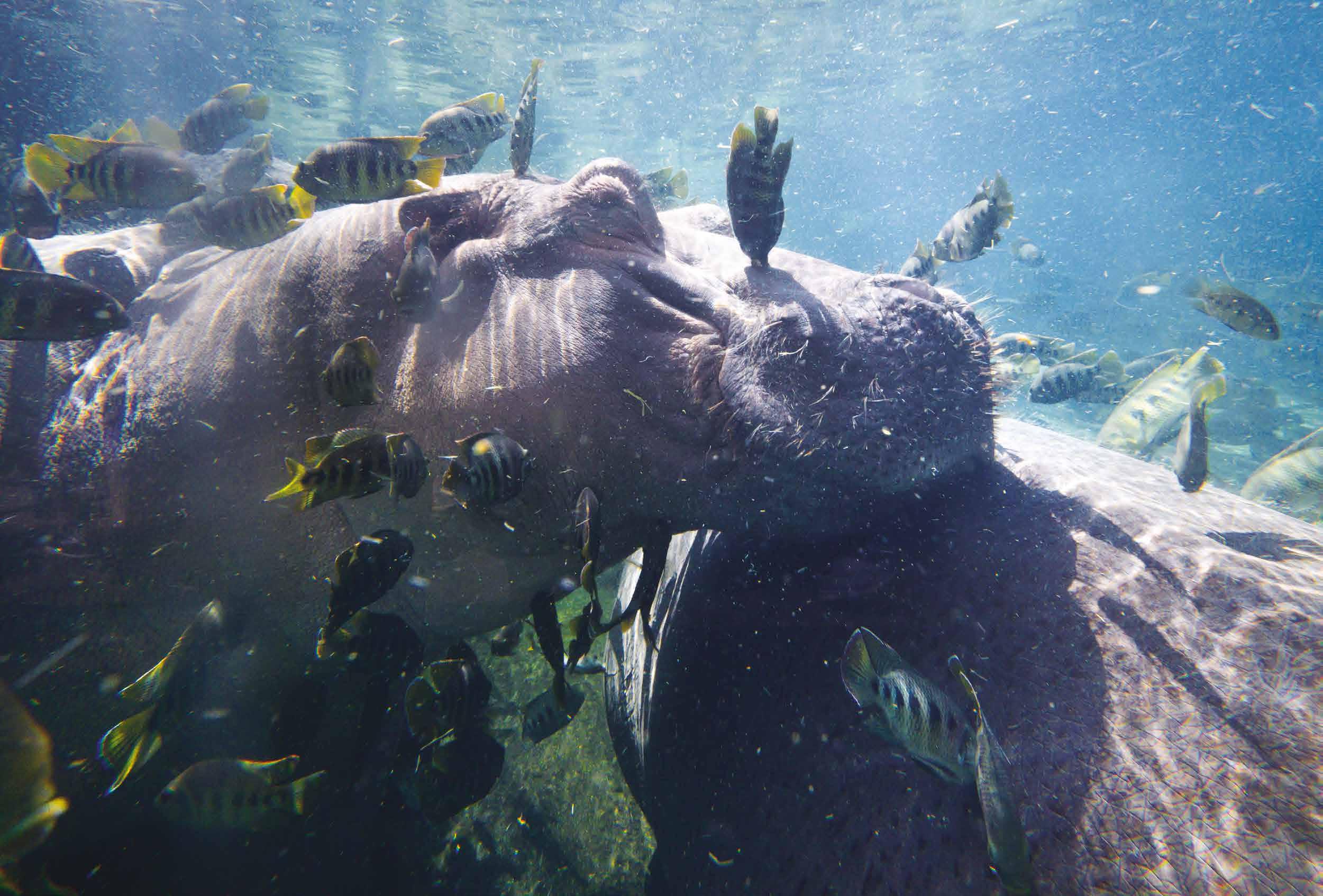SAINT LOUIS ZOO ASSOCIATION



I’m so glad spring is here. It’s refreshing to step into the warm breeze and just get out of the house. This past winter, I know many people felt like we stepped back in time to when the pandemic began. Many aspects of our lives went virtual again, and it was largely back to staying at home when possible. Now that the weather is warming up, people are spending time outdoors, and the Saint Louis Zoo is the perfect cure for cabin fever. I’m excited to walk around campus and see the Zoo in full swing after the quiet months of winter.
When you visit the Zoo this spring, you may see some new faces among our animals. True, spring is often a time for new babies, but we have plenty of new arrivals from other zoos and conservation organizations, too. In our cover story on page 4, we’d like to introduce you to a few newcomers to our Zoo family!
One of my favorite places at the Zoo is the Judy and Jerry Kent Family Sea Lion Sound. It’s incredible to see the sea lions and seals zoom overhead. Something you may not think about is how much thought and effort goes into managing all that water. Sea Lion Sound has 250,000 gallons of it. We also have aquatic habitats at McDonnell Polar Bear Point, Anheuser-Busch Hippo Harbor and Penguin & Puffin Coast, among other locations. Our animals’ lives depend on the quality of water. On page 10, read about our team’s care behind the well-managed water.
The next story in this issue highlights how necropsies — autopsies performed on animals — help advance several areas of animal science. Necropsies help determine cause of death as well as provide invaluable information to animal care experts worldwide. On page 16, meet Dr. Mary Duncan, our Zoo’s pathologist, and learn why necropsies are important for our work in animal care.
Unique animals can be found all around our Zoo. Did you know we have an animal in our care that can self-fertilize and is considered to be extinct in the wild? That animal is the Partula snail, which resides in the Bayer Insectarium. Read all about these snails’ wonderfully weird traits in our story on page 18. Invertebrate Keeper Glenn Frei is our resident expert on these snails, and you’ll hear his story about caring for these animals and how we work to conserve them.
We’ve got a lot on the calendar for this spring, so please check out all these happenings on page 20. From the reopening of Emerson Dinoroarus and Stingrays at Caribbean Cove presented by SSM Health, to the beginning of Jungle Boogie presented by Mid America Chevy Dealers, there’s plenty to keep you occupied and out of your house.
I hope you enjoy this issue of stlzoo magazine, and I thank you for supporting the Saint Louis Zoo.
COMMISSION OF THE ST. LOUIS ZOOLOGICAL PARK SUBDISTRICT
Chair
Cynthia J. Brinkley
Vice-Chair
Lawrence E. Thomas
Co-Treasurers Chonda J. Nwamu
Lawrence E. Thomas
Immediate Past Chair Winthrop B. Reed III
Commissioners
Karl A. Grice
Robert R. Hermann, Jr.
Jerald L. Kent
Robert F. O’Loughlin
Neal F. Perryman
Michael W. Riney
Peggy A. Ritter
Steven C. Roberts
Will R. Ross, MD, MPH Carol A. Wilson
Chairs Emeritus
Honorable James F. Conway
Steven F. Schankman
Mark J. Schnuck
President
Alicia S. McDonnell
Vice President
Robert B. Smith III
Treasurer James E. Williams, Jr.
Secretary Michael J. Hickey
Immediate Past President John R. Sondag
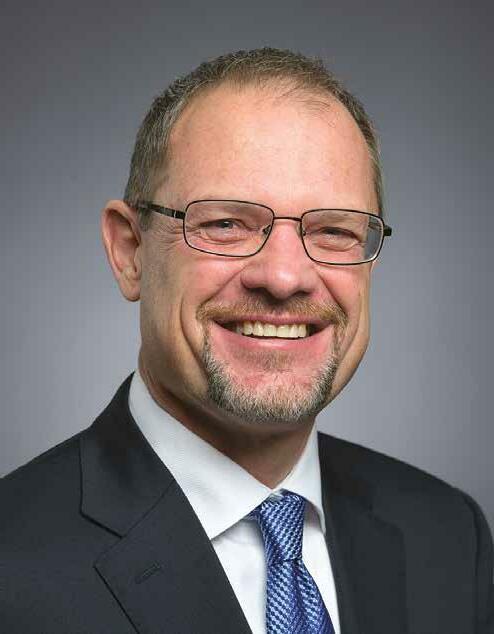
Executive Committee
Caryl L. Flannery
Pamela A. Glaser
Charles Henson
Mark W. Hubbert
Linda J. Hunter
Molly Hyland
Kenneth A. Johnson
Dr. Matthew R. MacEwan
Melissa Markwort
Jennifer T. McGrath
Lisa W. Nouss
Thomas P. Pollihan
Angela D. Schaefer
William R. Schmidt
Heather Wood
Susan S. Block
Cenia D. Bosman
Christine Boushka
Dr. Edmond B. Cabbabe
Mary B. Campbell
Debbie A. Caplin
Karen L. Condie
Hazel Alethea R. Donald
Edward Durham
Brad M. Edwards
Cory Elliott Kathy S. Federico
Logan W. Finerty
Lauren Thomas Fries
Matthew W. Geekie
Amy A. Gill
Brett G. Gilliland
Janis G. Goldstein
Kenneth H. Hannah
David P. Hatfield
Ricky L. Hopkins, Sr.
Ryan L. Hyman
Robert F. Johnston
Carol S. Klein
Lee C. Kling Judith B. Kouchoukos
James P. Leonard
Davida Lichtenstein
Julie Lilly
Sarah London
Dr. Dan W. Luedke
Ryan J. Martin
Anna McKelvey
John F. Meara
Julia Mize
Patrick J. Moore Dr. Stanley J. Niemann Bhavik R. Patel Pravina Pindoria Dr. Steven S. Pope Dana Tucker Redwing Stephen M. Reese Quirsis V. Riney James G. Sansone
Steven F. Schankman
Shelley Seifert Ashish Sinha
Torbjorn B. Sjogren Lisa K. Sullivan Dianne Sutcliffe Kevin Travers Virgil Van Trease Lottie Wade Matthew A. Wagner Gerald E. Wiley Robert M. Williams, Jr.
We have some new faces among our animals! Allow us to introduce you to a few of them.
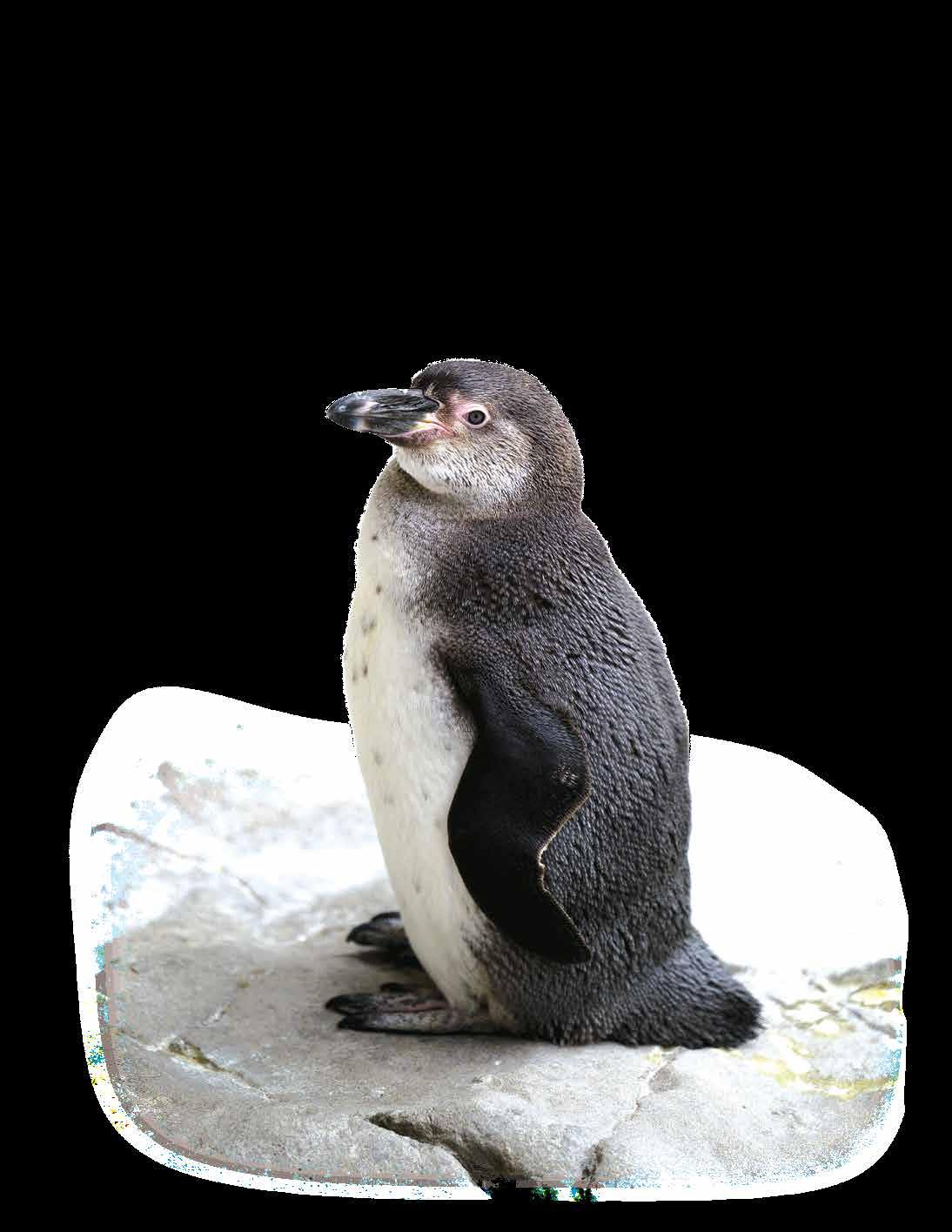
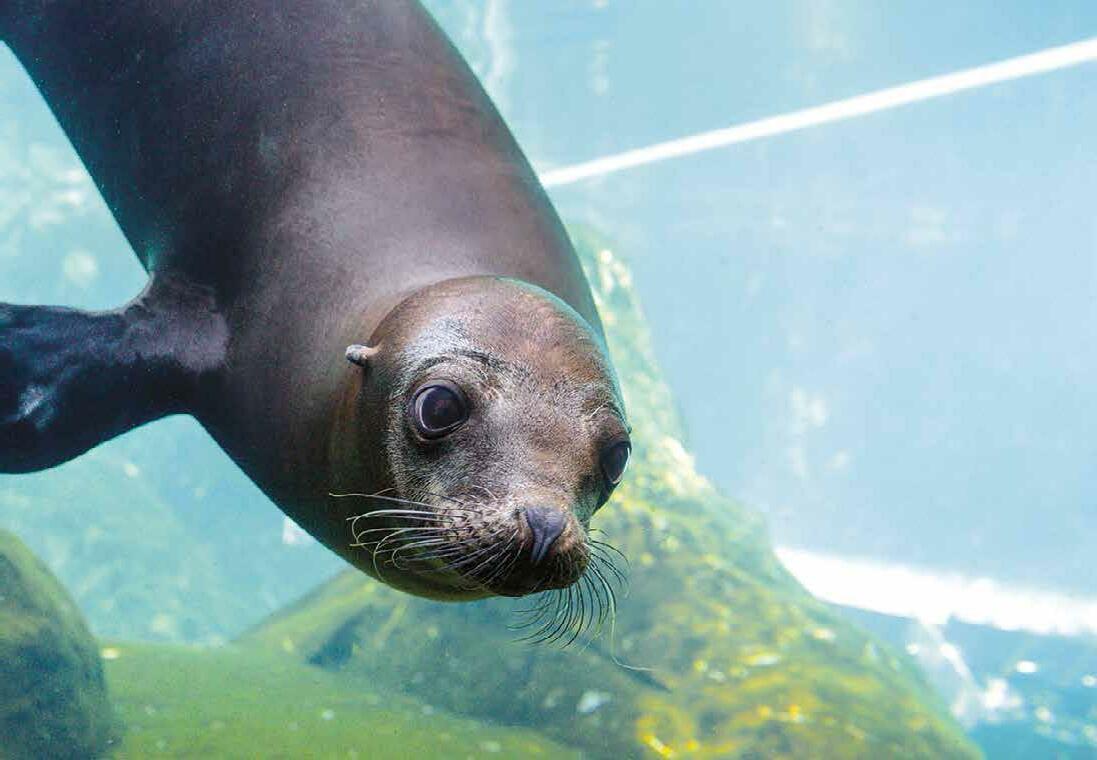
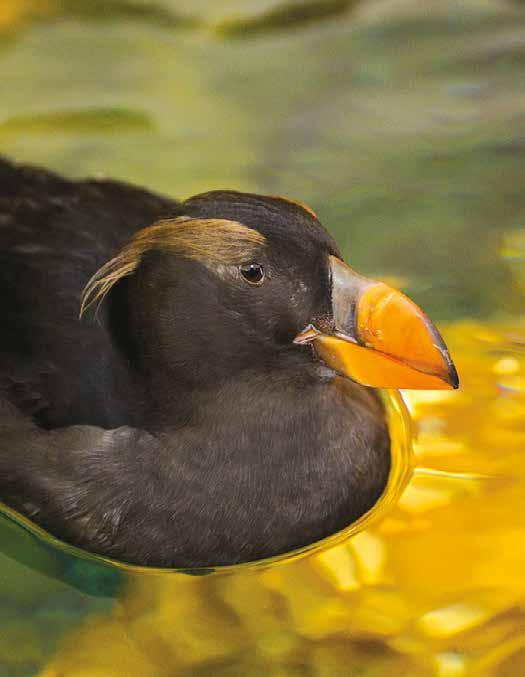
Healthy, well-managed water is essential for many Zoo animals. Learn about the effort it takes to care for this important resource.
We care for animals in all stages of life — even after death. Get a (non-graphic) glimpse into how important necropsies are for animal care.
stlzoo is published quarterly as a member benefit by the Saint Louis Zoo Association, One Government Drive, St. Louis, MO 63110.
Permission to reprint any material is granted, provided proper credit is given.
n Managing Editor: Rebecca McMiller
n Editorial Assistance: Billy Brennan, Jill Gordon, Kirby Meyer, Elaine Vydra
n Graphic Design: McCord Design Group
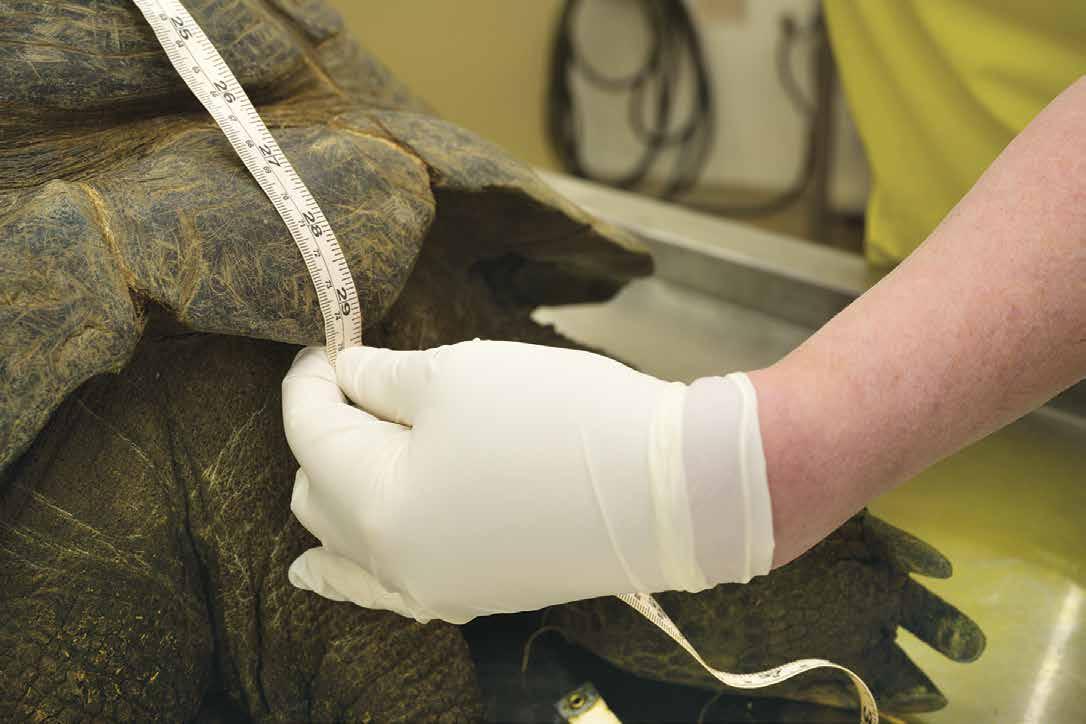
n Contributing Photographer: Ray Meibaum
n Contributors: Members of the Zoo staff
At the Saint Louis Zoo, we not only care about the conservation of animals, but also about the conservation of the environment. That is why stlzoo magazine is created using FSC- (Forest Stewardship Council) certified paper with recycled materials and eco-friendly inks.
Spring is upon us, and that means warmer temperatures and time to plan outdoor activities. What better way to take in the fresh air and sunshine than a trip to the Zoo? As a member, you already know the benefits of membership make it even easier to spend the day with loved ones while enjoying over 14,000 animals.
Springtime also means the reopening of Emerson Dinoroarus. When you visit, be sure to look for a few new attractions that have been added within the exhibit. Best of all, your membership includes admission tickets to this popular attraction. The Michael and Quirsis Riney Primate Canopy Trails exhibit also has been extremely popular with all ages. Overhead mesh tunnels connected to the Primate House lead to preexisting, live trees and other outdoor habitats with spaces for the animals to climb and perch. These “sky trail” tunnels have a flexible design that allow animals to explore different habitats at different times, boosting the stimulation in their daily lives. On any given day, a group of primates could be in a wide variety of habitats.
Zoo Friends Day is 3 to 8 p.m. on Friday, May 6. The Zoo will be open late just for our members! This event is all about you, and it’s our way of saying thank you for being a member. Bring your membership card and enjoy free parking (based on availability), Stingrays at Caribbean Cove presented by SSM Health, Emerson Zooline Railroad, the Sea Lion Show, Dinoroarus, Mary Ann Lee Conservation Carousel, special activities and more! And don’t forget, on this special day, members will receive a 20% discount on gift shop purchases.
If you’re looking for fun and educational opportunities for summer, look no further than the Zoo! There are many virtual and in-person programs from which to choose. Visit stlzoo.org/education for the complete catalog and links to register. n
Please bring your membership card with you on each visit to the Zoo to enjoy your free parking and attraction benefits. Please note: If you visit without your card, you may retrieve your member tickets at either Welcome Desk but not at the various attraction locations.
The first-ever Zoo Young Professionals Yoga and Brunch at the Zoo event takes place on April 30. Whether you’re a beginner or seasoned yogi, you’re sure to enjoy an hour-long class taught by a certified yoga instructor against the backdrop of Historic Hill. Afterward, you can enjoy a delicious brunch, complete with bloody marys, mimosas and a DJ. For tickets, visit stlzoo.org/yoga.
Some of you have asked, and yes, Jammin’ at the Zoo will return this year! As a ZYP member, you’ll be able to use your free tickets at Jammin’ at the Zoo or
Night at the Zoo presented by Mercy. Whether you prefer to have a low-key night out with a few close friends or welcome the return of beer and wine tasting with live entertainment, you have a choice. Email invitations will be sent before the events.
Are you in your 20s or 30s and interested in receiving invitations to Zoo Young Professionals events? Even if you’re a member at any other level, we’ll add you to the list. Just send an email to membership@stlzoo.org. n
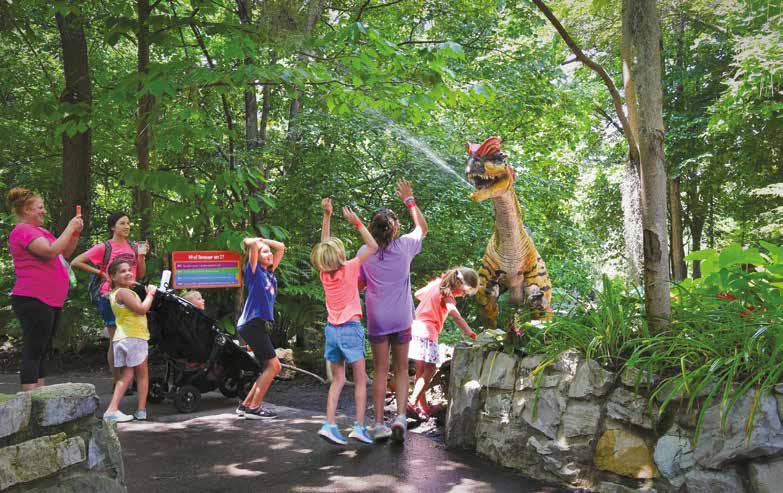
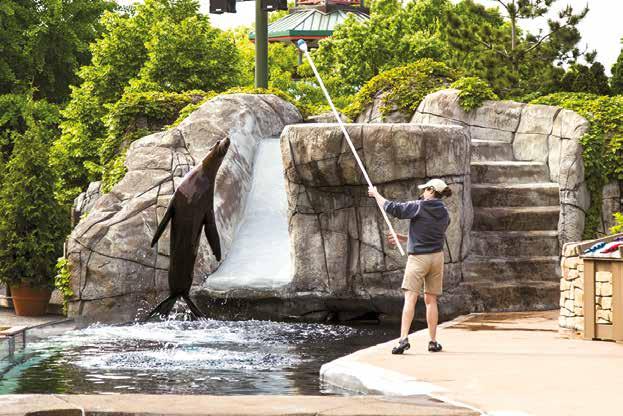
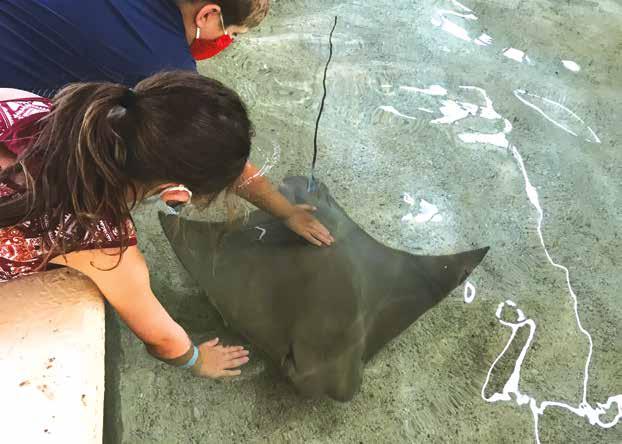

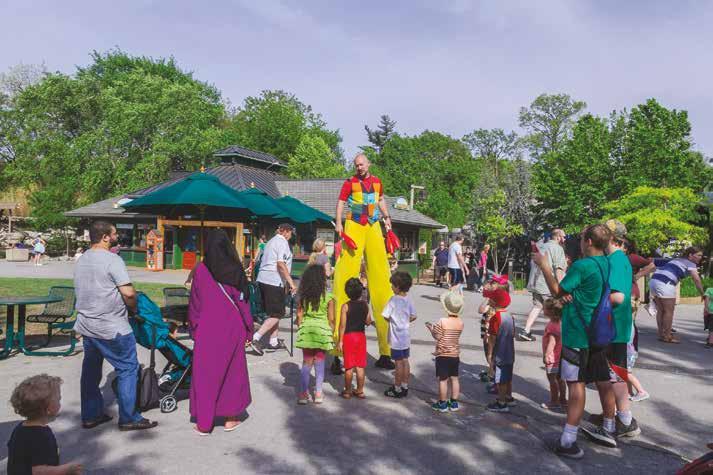
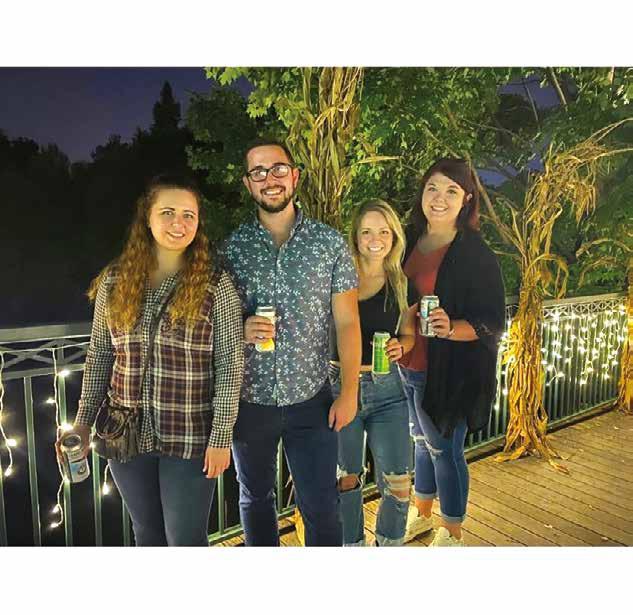
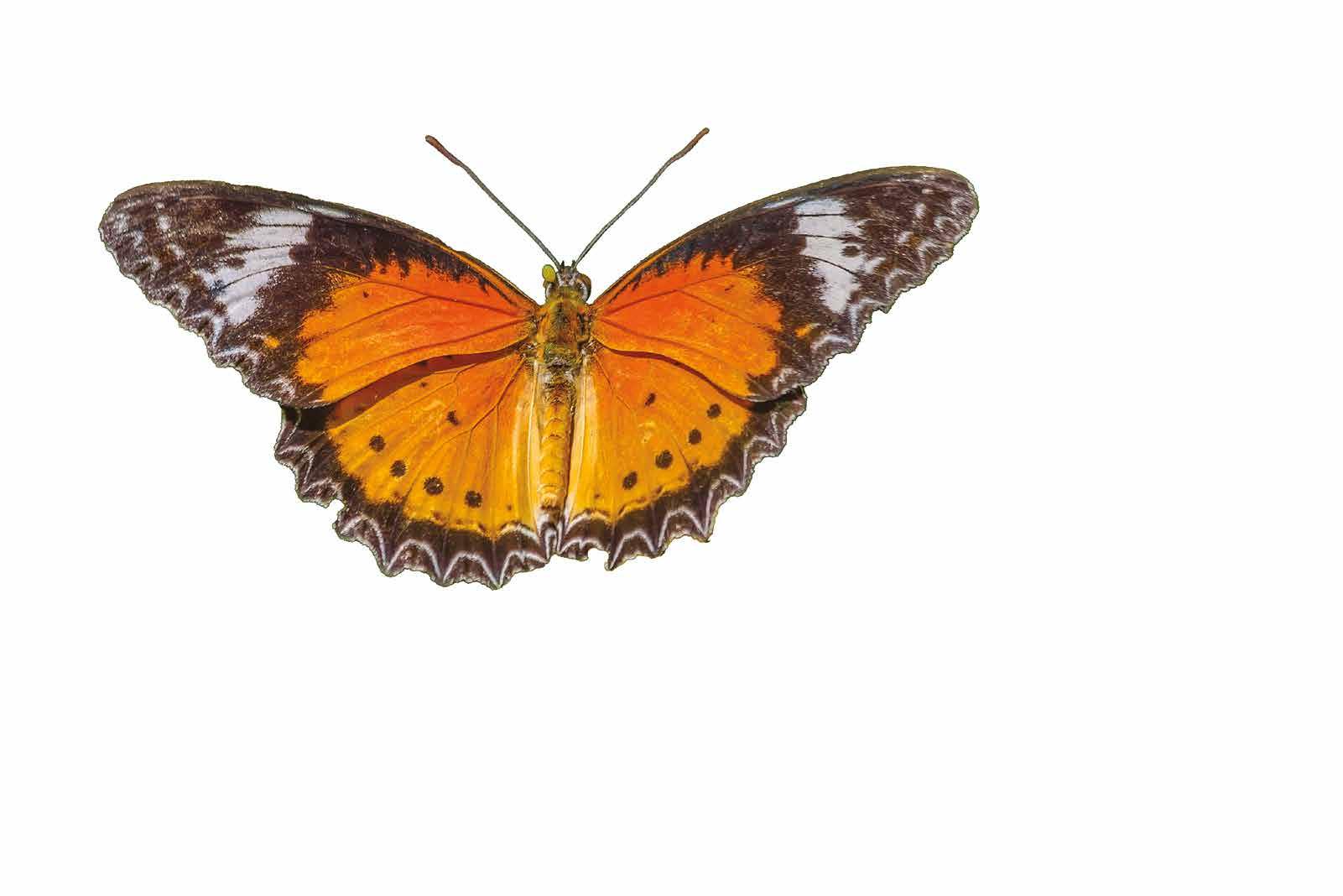
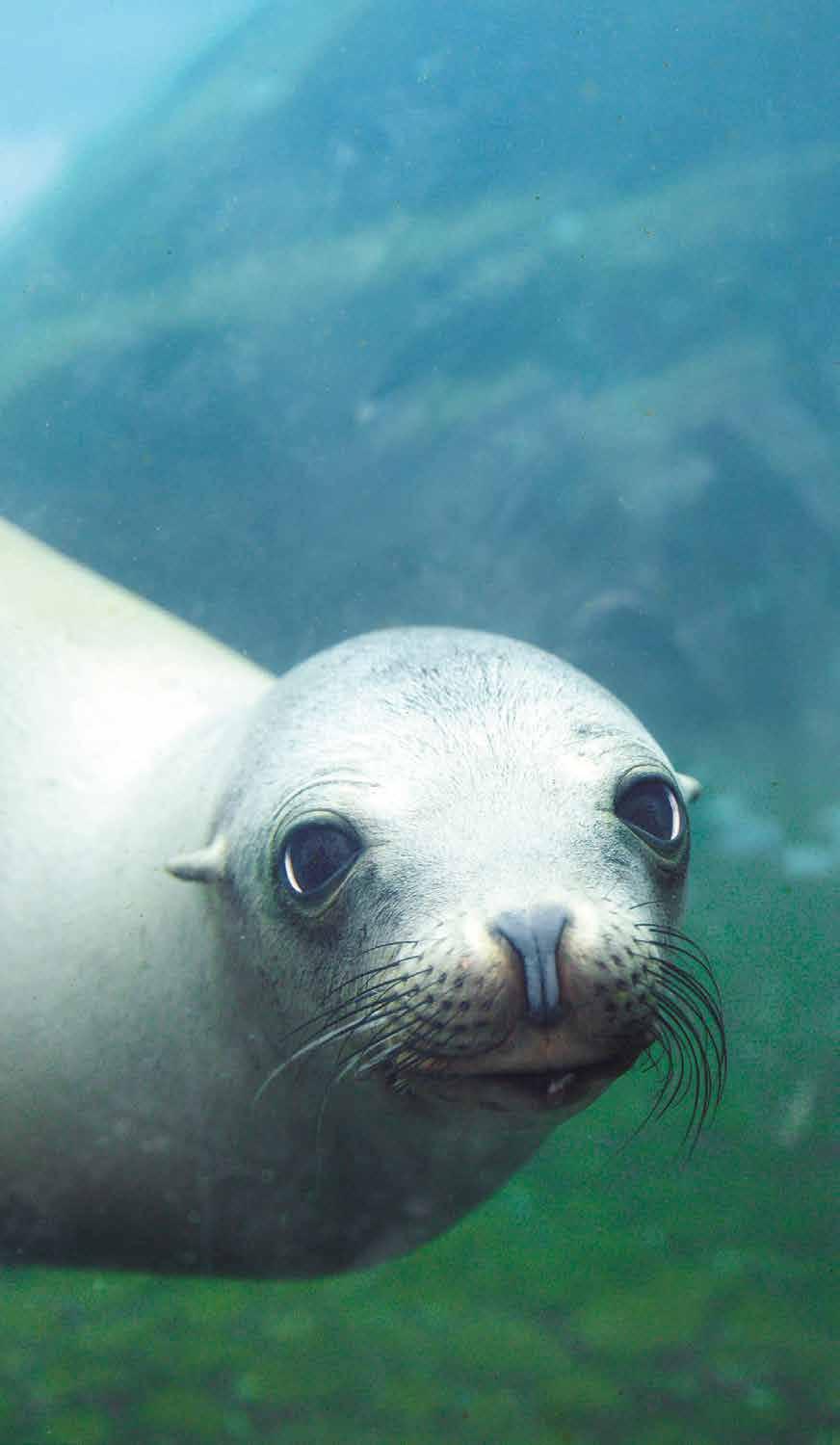
Our family at the Judy and Jerry Kent Family Sea Lion Sound got a little bit bigger in late 2021! Two young female California sea lions arrived in St. Louis in October. Nova was born on July 5, 2020, and is the lighter colored and larger of the two. Kit, who was born on July 6, 2020, is darker and smaller. After spending time in quarantine (standard protocol for all new Zoo animals to ensure they are healthy), Nova and Kit made their way to Sea Lion Sound. They were slowly introduced to the rest of our pinniped family and their new home! While we are still getting to know their individual personalities, Kit tends to be a little bit braver when investigating new things, such as enrichment items like puzzle feeders. Nova, however, seems to be less shy in interacting with the other animals.
Once they arrived at Sea Lion Sound, we started their training, working with them several times a day. Initially, we focused on simple behaviors, such as name recognition, holding still, following us around
and going to the water. Now, we are conditioning Nova and Kit to understand that the sound of a whistle (or the word “good”) means they carried out a behavior correctly — and a fish is on the way! Both girls are very smart and quickly picked up on several of these key behaviors.
Since our facility involves several different areas, we have introduced Nova and Kit to each area and are getting them accustomed to moving between habitats. Along with learning their names, the sea lions also are learning to identify and come to a shape that is specific to each of them: Nova’s shape is a sea turtle, and Kit’s shape is a seahorse.
Nova and Kit spend quite a bit of time together, so we are working on their confidence during their oneon-one training sessions. As they continue to progress, we will begin to train husbandry behaviors, such as presenting body parts for inspection, opening mouths and teeth brushing. This training is especially important as it encourages the animals to participate

Nova is the lighter colored and larger of the two animals. Kit is darker and smaller.
in their own health care. We also will focus on behaviors that showcase their natural abilities (e.g., fast swims, jumps, movements with flippers).
With our show season on the horizon, the new girls will get to know the show arena, where our guests will hopefully be able to see Nova and Kit in action in the near future! In the meantime, come visit Sea Lion Sound and try to spot Nova and Kit among their new friends!
If you haven’t been to the Saint Louis Zoo in a while, you may see some unfamiliar faces, as many new animals now call the Zoo home!
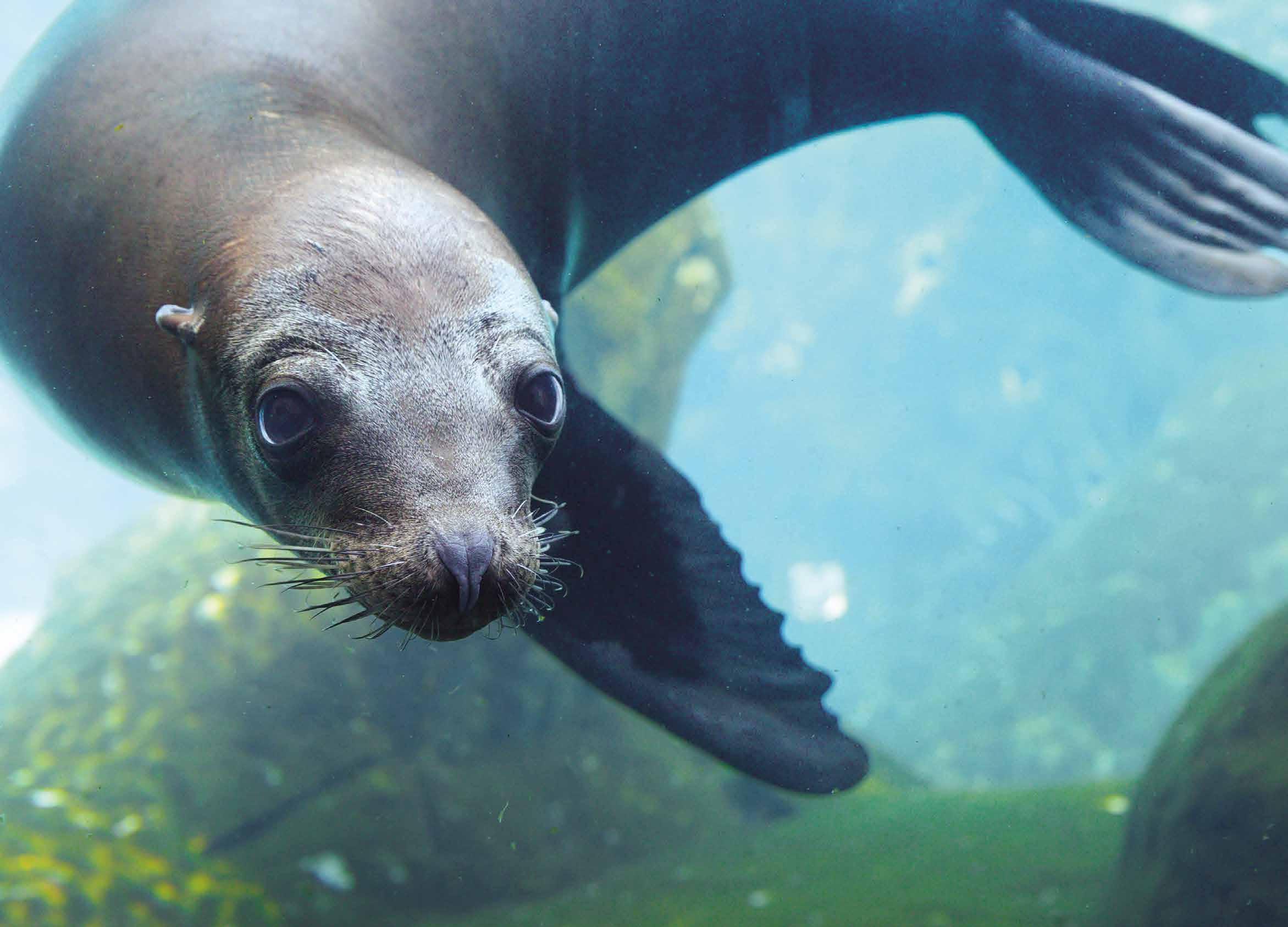

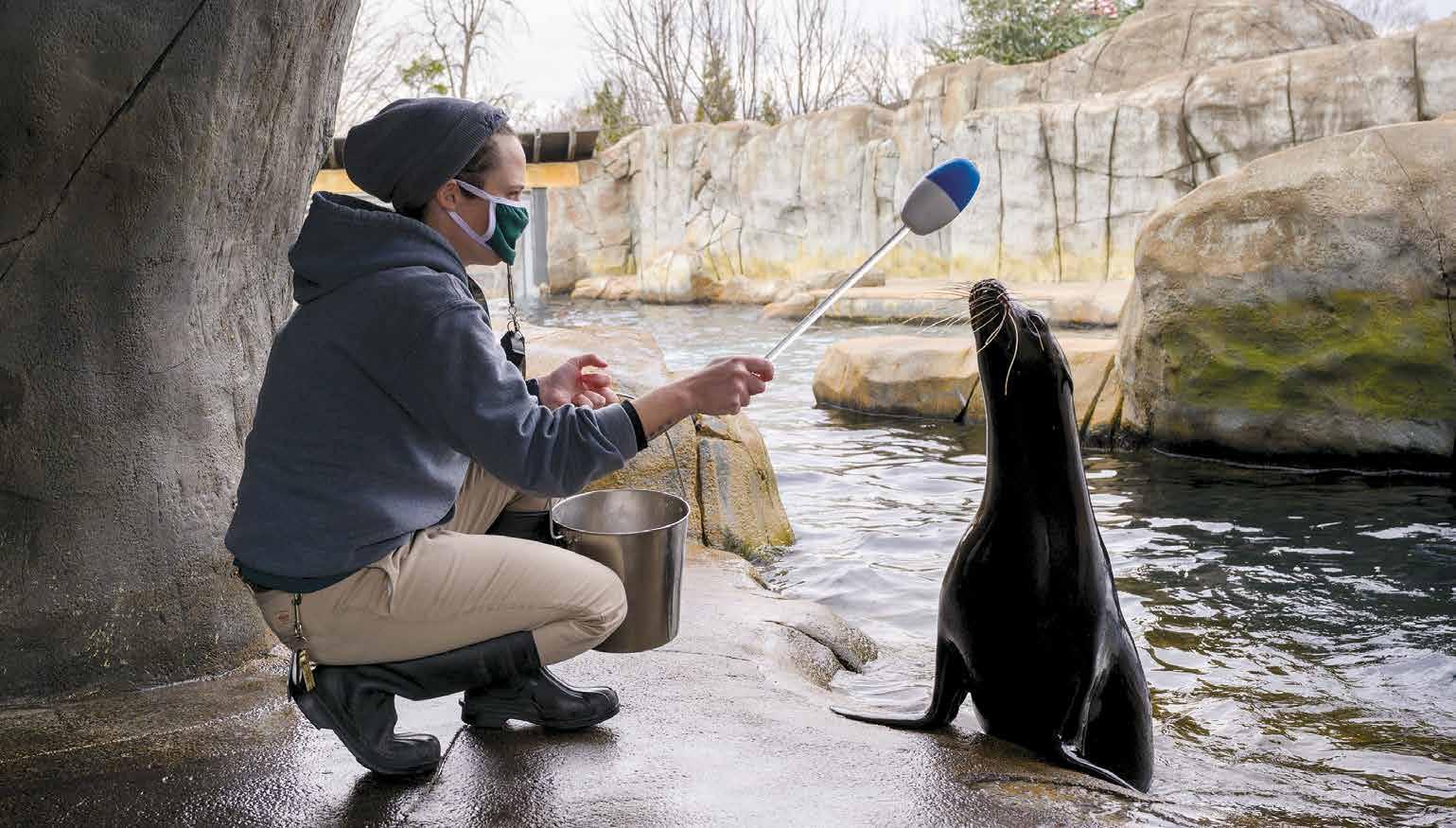
In 2021, we celebrated 4,788 births, plus 606 animals came to us from other zoos and conservation organizations. Although we can’t feature all of these newcomers, we’d like to introduce you to some of them.
We are continuing to work on conditioning the girls to understand that a whistle or the word ‘good’ means they did a correct behavior and a fish is on the way! ” “
Each penguin chick is dutifully cared for by our team for almost 100 days before the chick becomes independent enough to feed itself. ” “
BY MARIJA ELDEN, ZOOLOGICAL MANAGER OF BIRDSThe winter months were a bustling time for Penguin & Puffin Coast keepers, as it was the breeding season for the sub-Antarctic gentoo, king and rockhopper penguins. It is not unusual to see downy king or rockhopper penguin chicks being tended to by their parents on habitat. During this recent breeding season, we welcomed one king penguin, one rockhopper penguin and four Humboldt penguins.
Penguin parents work around the clock to provide meals for their chicks, and our team makes sure that there is a steady supply of fresh mackerel, herring and capelin to keep the parents fueled. Bird keepers monitor the weight
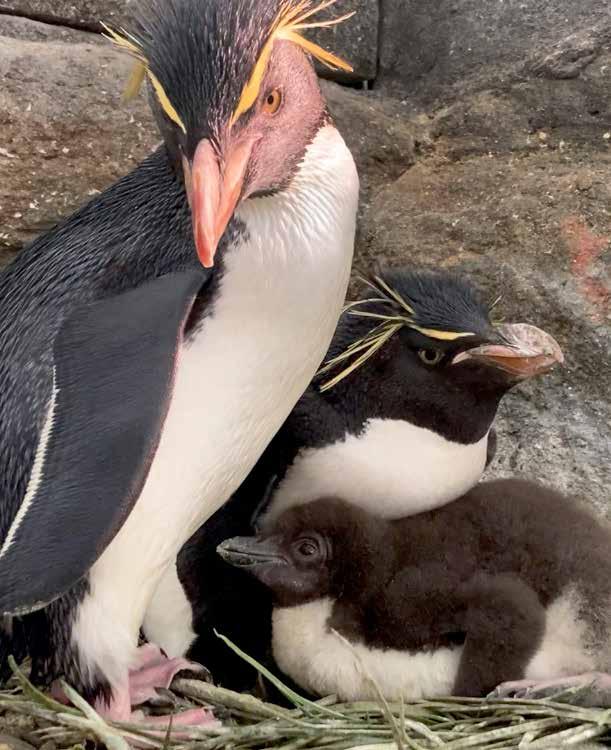
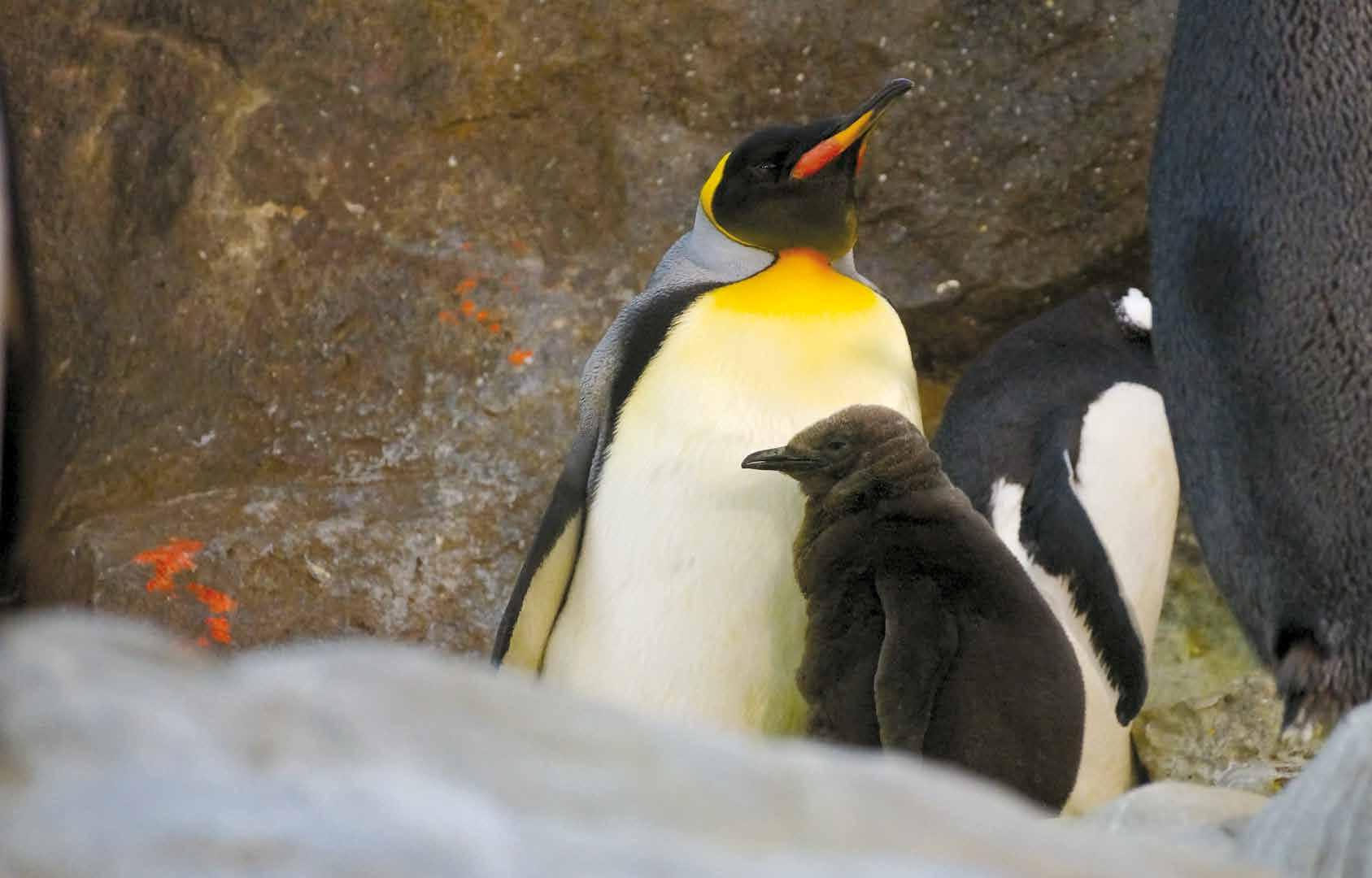

of penguin chicks daily to make sure that each is gaining at least 10% of its body weight per day. Soon, the chicks become almost larger than the parents and do not need to be kept warm by them. At this stage, they become more independent from their parents and form a loose group of chicks, called a creche. This creche allows the chicks to travel together to explore their environment while maintaining safety in numbers.
We move the chick, or creche if there is more than one chick, from their public-facing habitat to make sure that downy chicks do not stray into the water. This independent period is a
particularly crucial time for our team to build relationships with penguin chicks so they can establish important skills, including hand-feeding fish from staff and learning to stand on a scale. The chicks learn how to gently take whole fish, such as capelin, smelt and herring, from their caregivers. This important skill allows our team to deliver a daily vitamin for optimal health, and also creates an important bond between penguin and staff.
Downy feathers give way to sleek juvenile feathers, signaling

the beginning of swim lessons. Our team carefully allows penguin chicks supervised swim time in a behind-the-scenes pool. Once the skills are solidified, staff will accompany chicks on daytrips to the Penguin & Puffin Coast habitat where the chicks get to show off their swimming styles and meet new friends. Over time, chicks stay on habitat longer and longer until they are fully independent.
Each penguin chick is dutifully cared for by our team for almost 100 days before the chick becomes
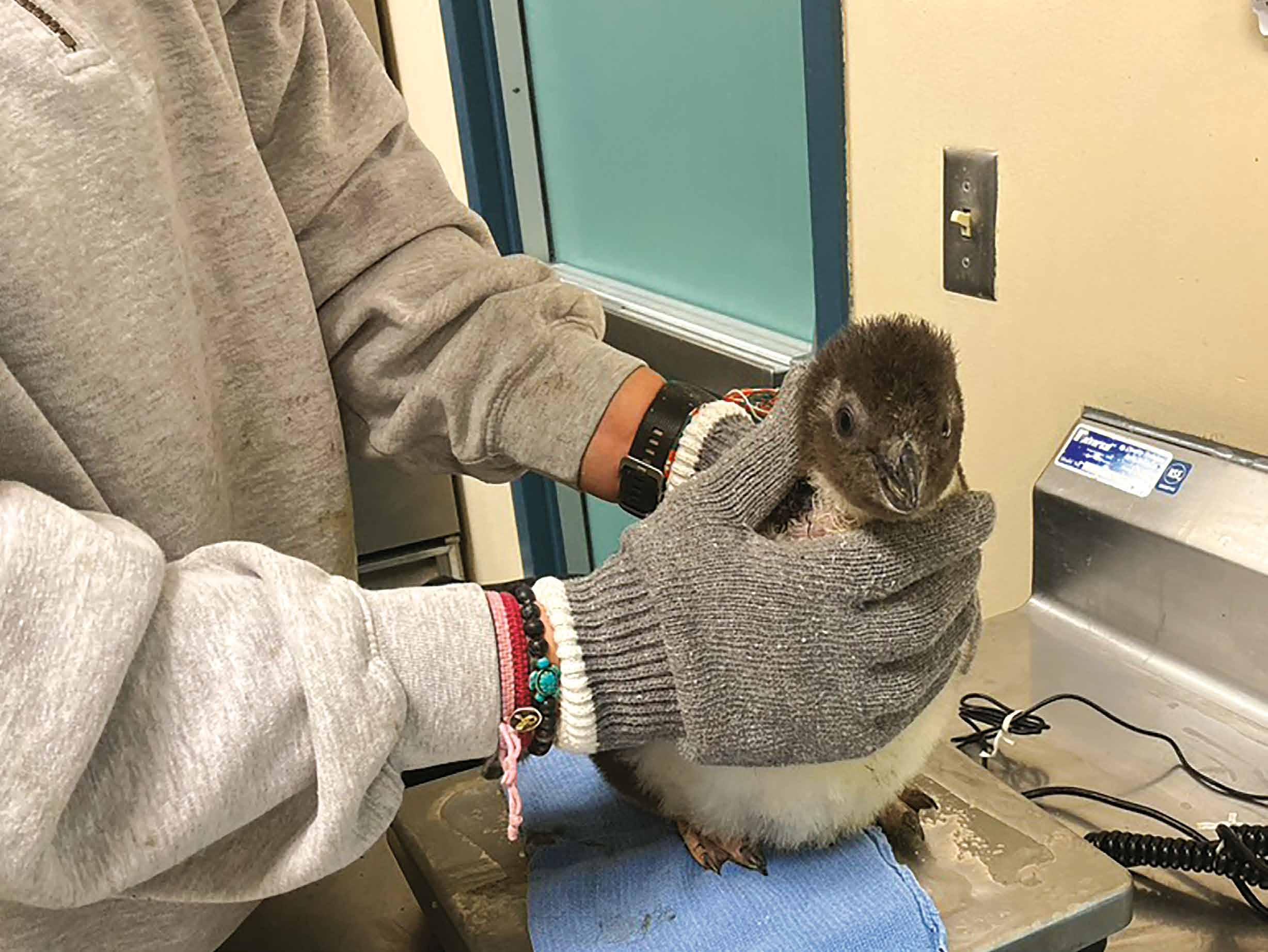
independent enough to feed itself. When a bird is gaining 10% of its body weight daily, they grow quickly. Though guests might not see what looks like a baby penguin in the habitat, that does not necessarily mean that there isn’t a penguin in the habitat that’s still very young. Members of our team at Penguin & Puffin Coast are on habitat multiple times throughout the day, and we’re available to talk with Zoo guests. We are more than happy to answer questions about which individuals in our colony are “babies”!
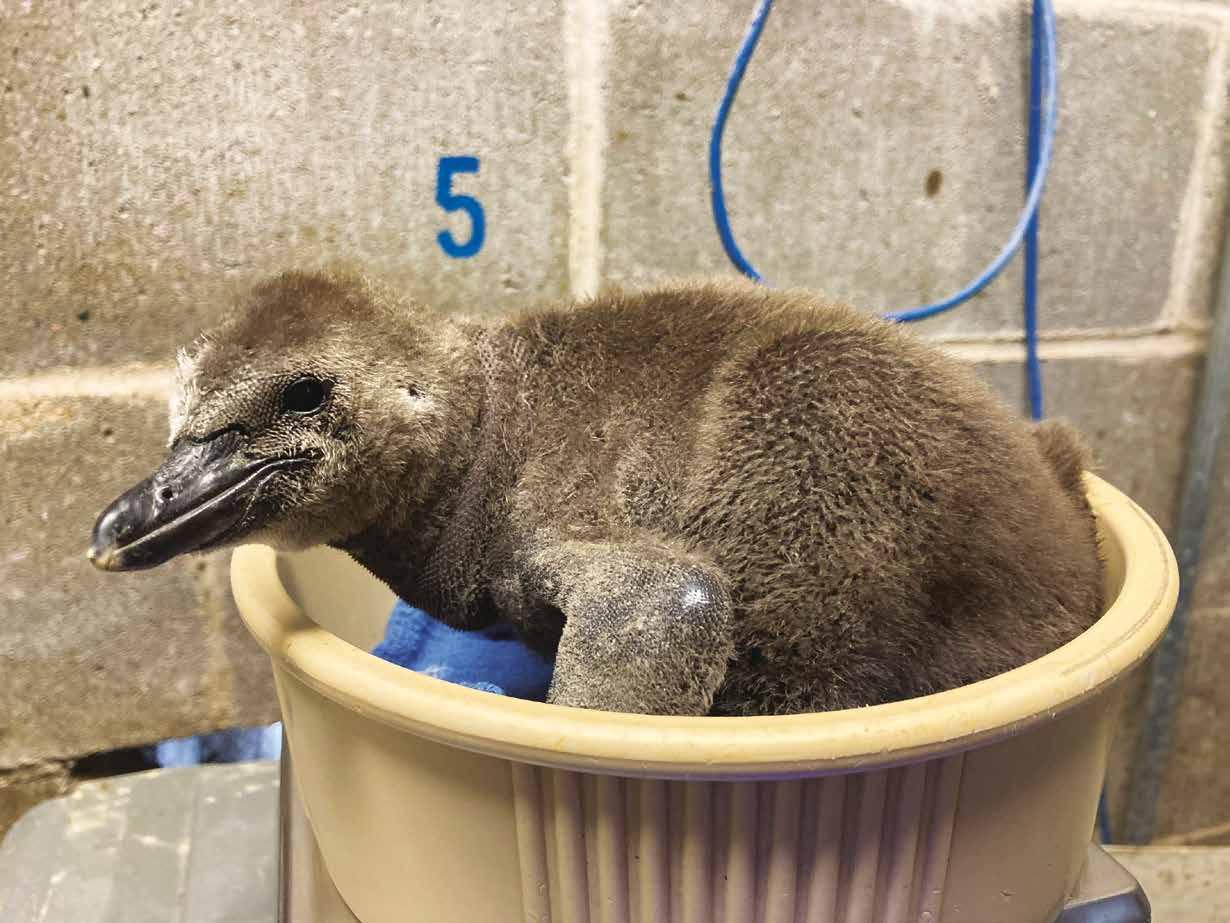
If you are looking for him at the Zoo, he is often seen resting and looking out from on top of his den. Your best bet at viewing him is early in the morning when he first gets outside, or later in the day.
BY JACKIE MCGARRAHAN, CARNIVORE KEEPERMeet the new handsome guy who calls Big Cat Country home! Samson is a 3-year-old male Amur leopard who came to the Saint Louis Zoo from Chicago this past fall. He spent some time adjusting to his new life here before joining our female, Dot, in their habitat, where they can now be seen together!
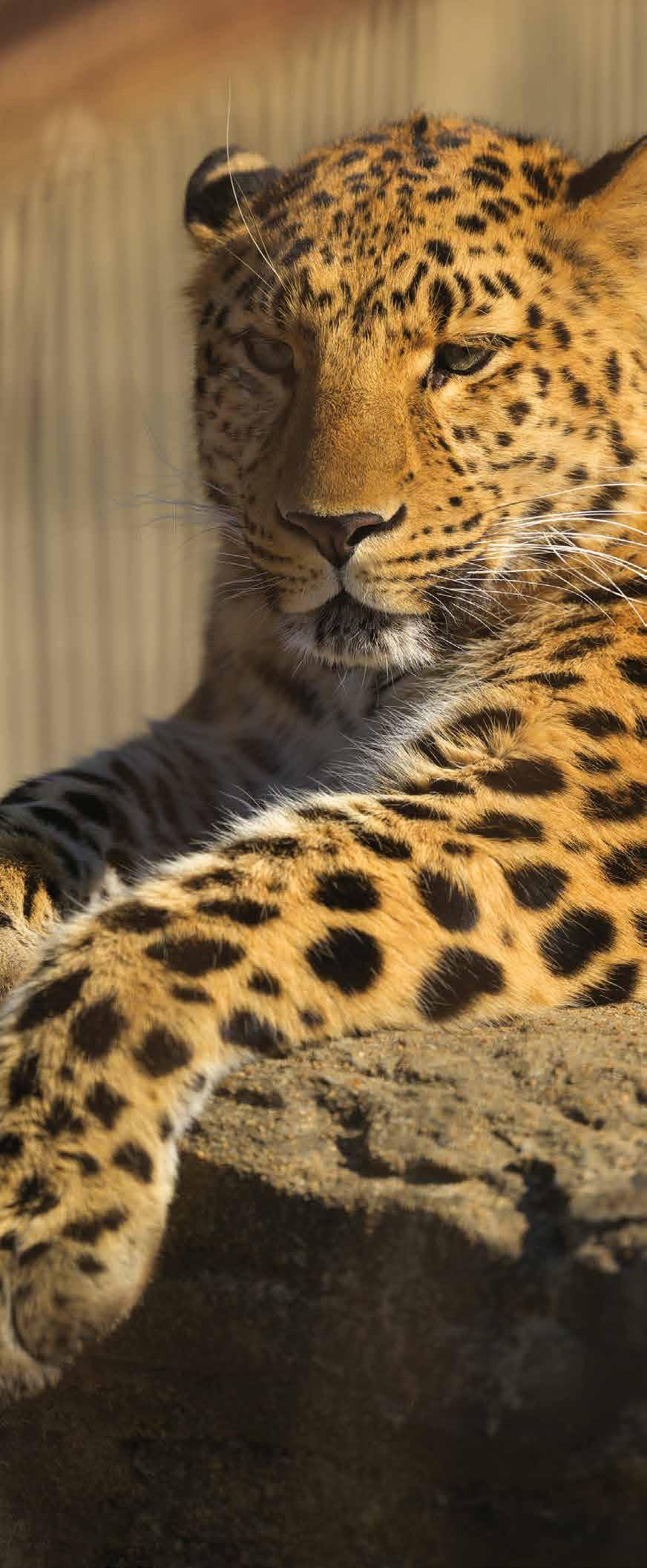
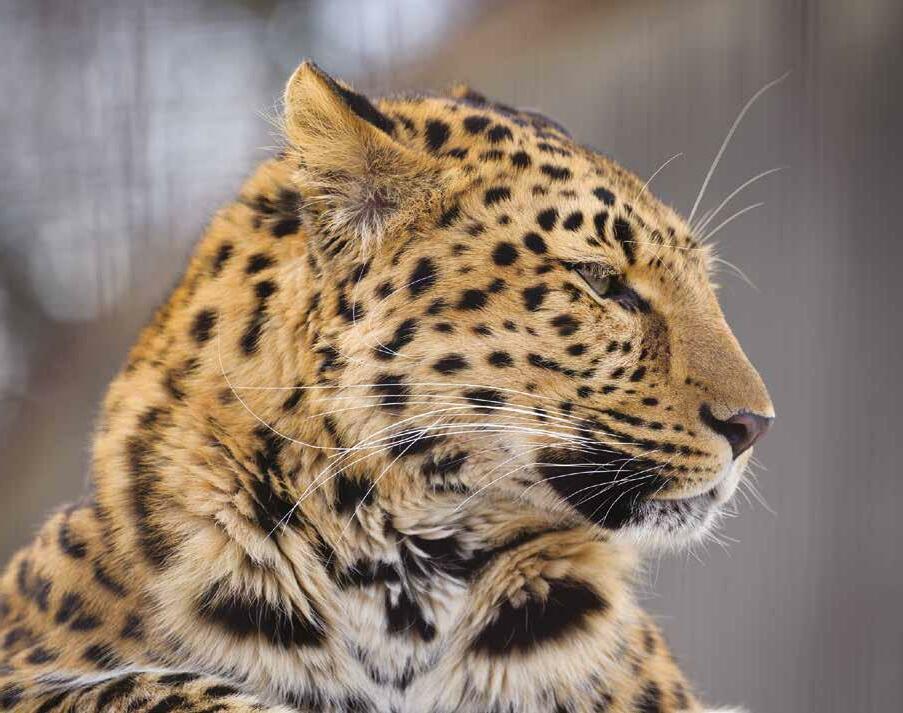
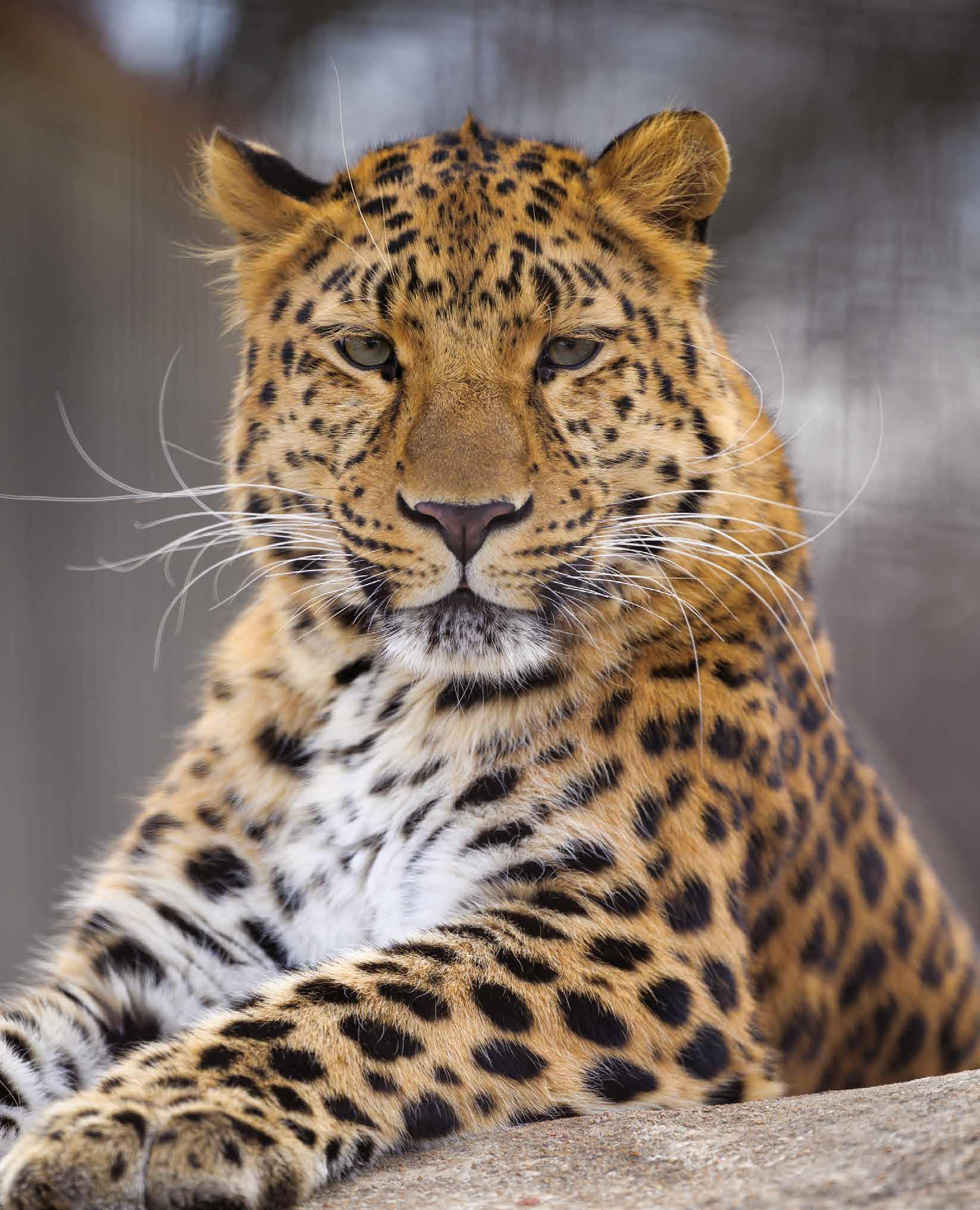
This shy guy takes a while to warm up, but once he is comfortable, his bright personality really comes out. He is interested in keepers and will
sit down and watch what we are doing if he can see us. He will often choose to spend time near keepers, if given the option. Samson is a very intelligent and food-motivated boy. He also enjoys scent enrichment. He will rub on or roll in anything that smells different!
Samson actively participates in our training program. In his short time here, he has already mastered multiple behaviors to allow him to participate in his own care. He will follow a target,
lie down, stand on his back feet with his front feet up on the fence, and allow an injection into his hip. Samson was one of the first animals at the Zoo to receive his COVID-19 vaccine, and he received it voluntarily. He was trained to present his side to the mesh, and we were able to give him his vaccine with little to no stress on his end.
Samson may have just made the move to St. Louis, but he has a family connection to our city. His mother, Anastasia, was born here at the
This shy guy takes a while to warm up, but once he is comfortable, his bright personality really comes out. ” “
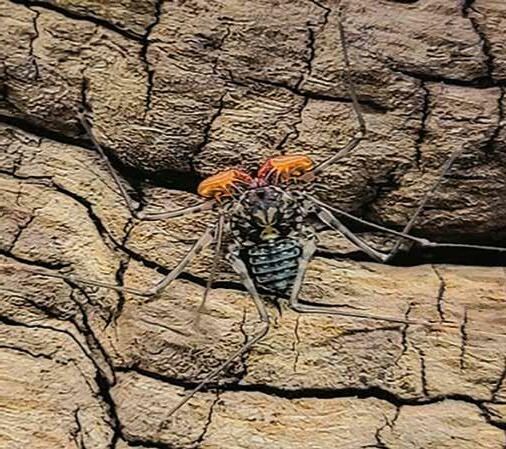

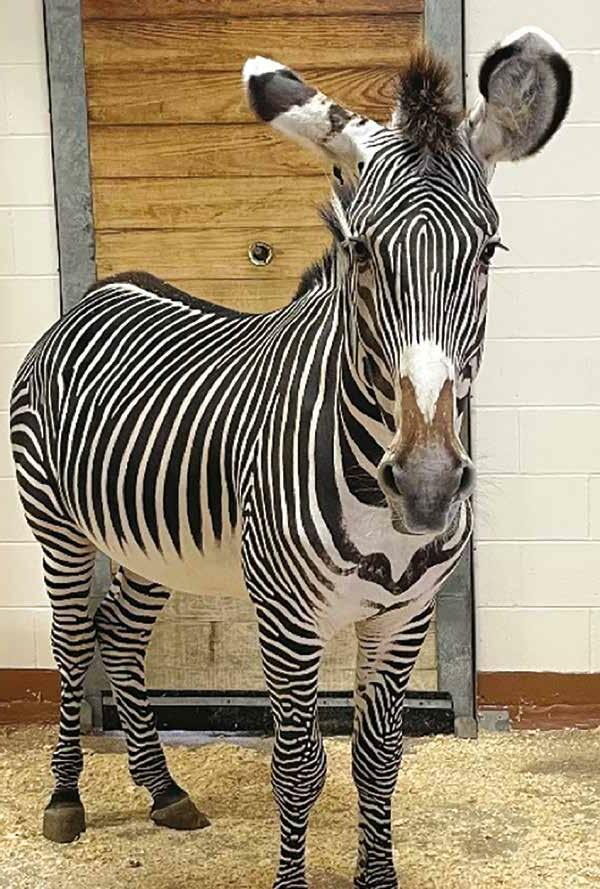
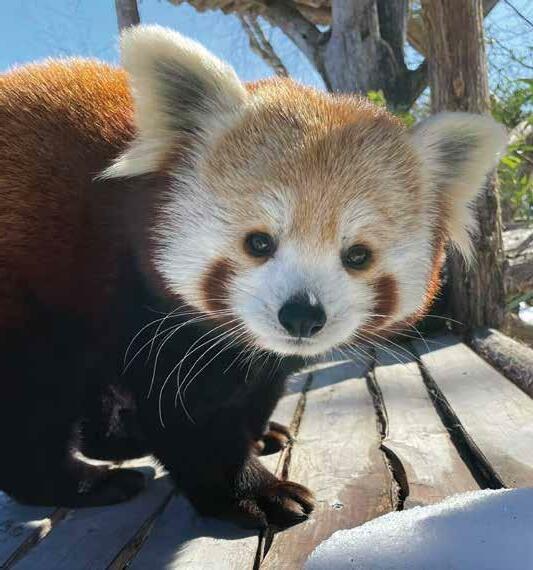
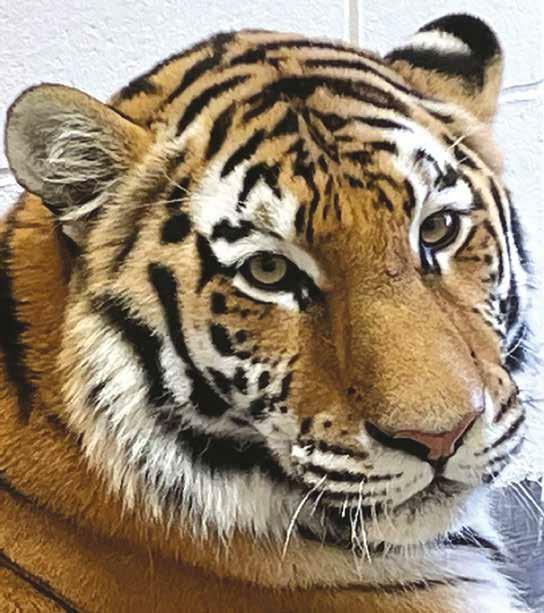
Saint Louis Zoo to a previous pair of Amur leopards — named Mona and Erskine. Some of his keepers have had the pleasure of caring for his mother and grandmother as well!
If you are looking for him at the Zoo, he is often seen resting and looking out from on top of his den. Your best bet at viewing him is early in the morning when he first gets outside, or later in the day. When it comes to telling the Amur leopards apart, it can be pretty difficult, even for us! Samson is significantly larger than Dot — this is the easiest way to tell them apart if they are near each other. Samson has one large spot above his left eye with smaller spots around it, and Dot has even-sized spaces and spots above her right eye. We hope you can “spot” him next time you’re at the Zoo! n
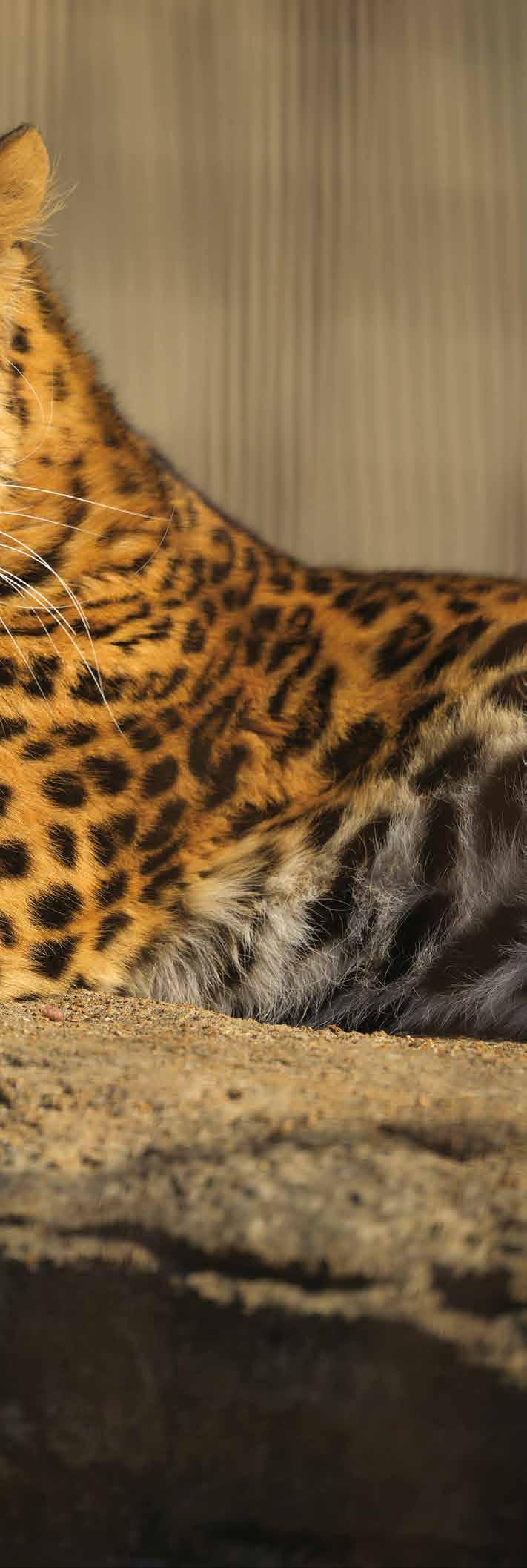

You likely recognize the line above from Pixar’s “Finding Nemo.” In a related scene of this delightful movie, Dr. Philip Sherman, the goofy dentist with good intentions, intends to clean and treat his fish tank. In this hypothetical situation, cleaning the tank will be a hassle — emptying the dirty water, removing the animals, sanitizing the space and obtaining clean, well-managed water takes a fair amount of time — but nothing to be worried about. As we hear when he calls to his assistant, it can be completed by himself in an afternoon. But, instead of a few gallons of water, imagine you had to work with over a million. Replace a number of small fish with full-grown California sea lions, harbor seals, hippopotamuses, a variety of penguins and puffins, alligators, and even a polar bear. Lastly, note that each
species of animal may need different water treatments, water quantities and water sources.
Now you are starting to see the herculean care of water in our habitats at the Saint Louis Zoo.

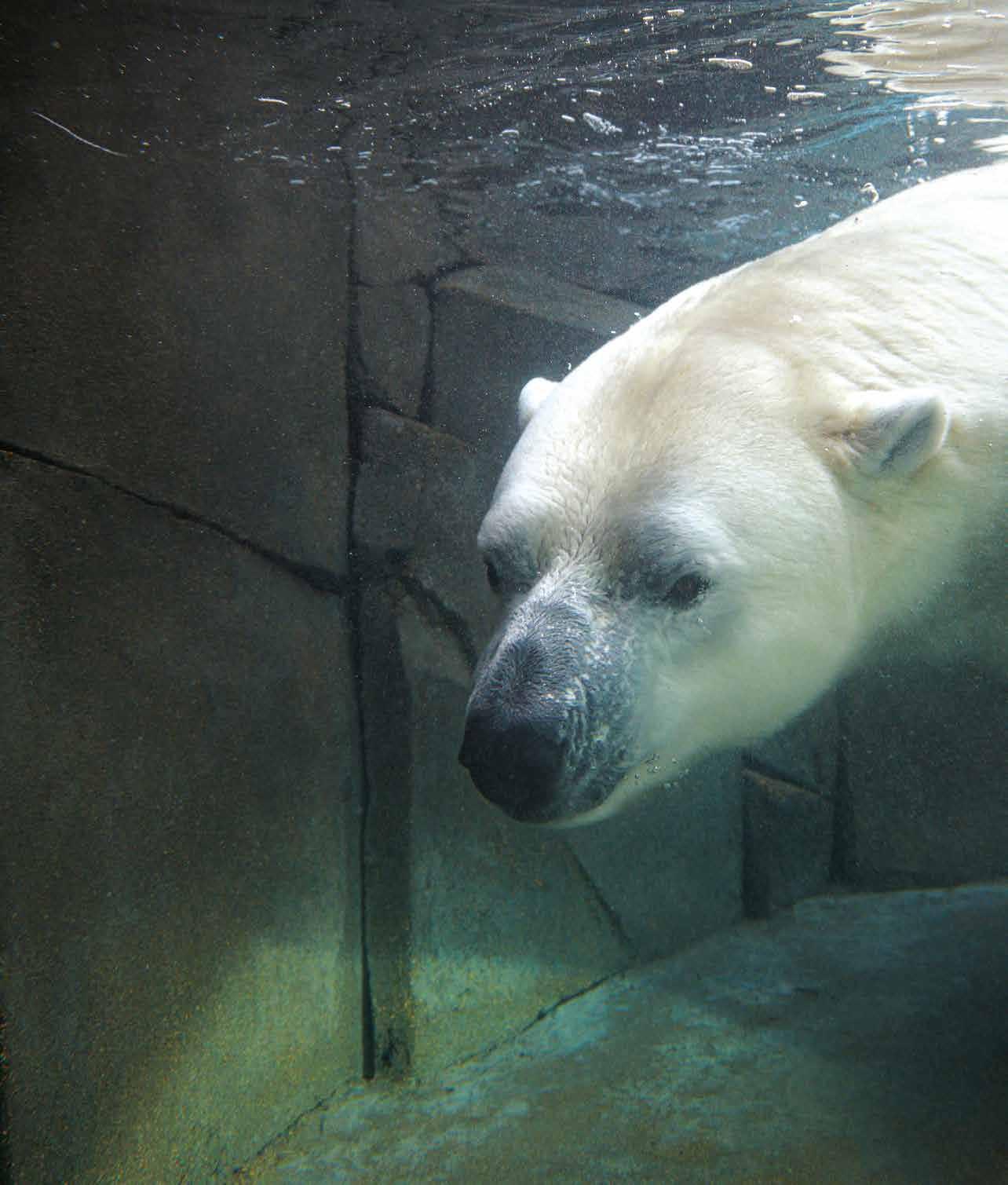
From Penguin & Puffin Coast to the Charles H. Hoessle Herpetarium, Judy and Jerry Kent Family Sea Lion Sound to McDonnell Polar Bear Point, water is a key part of the habitats of many animals. Water to drink, water to bathe in, water to play with and sometimes water to breathe … the importance of this resource cannot be overstated. Without healthy, well-managed water, it would be impossible for many animals to call the Zoo home.
Healthy water is the product of the life support systems that keep our habitats up and running. It also is an integral part of the Zoo’s conservation efforts, including the inspiring story of the hellbender.
‘The sun is shining; the tank is clean!’
THE HABITATS OF MANY
As a member of the Zoo, you have likely heard of our efforts and successes in establishing a conservation breeding program and husbandry protocols for successfully rearing hellbender larvae to sexual maturity. The Zoo’s breeding program for hellbenders has helped ensure the future for this unique amphibian, and our success could not have been accomplished without focusing on finding water that works for this aquatic species.
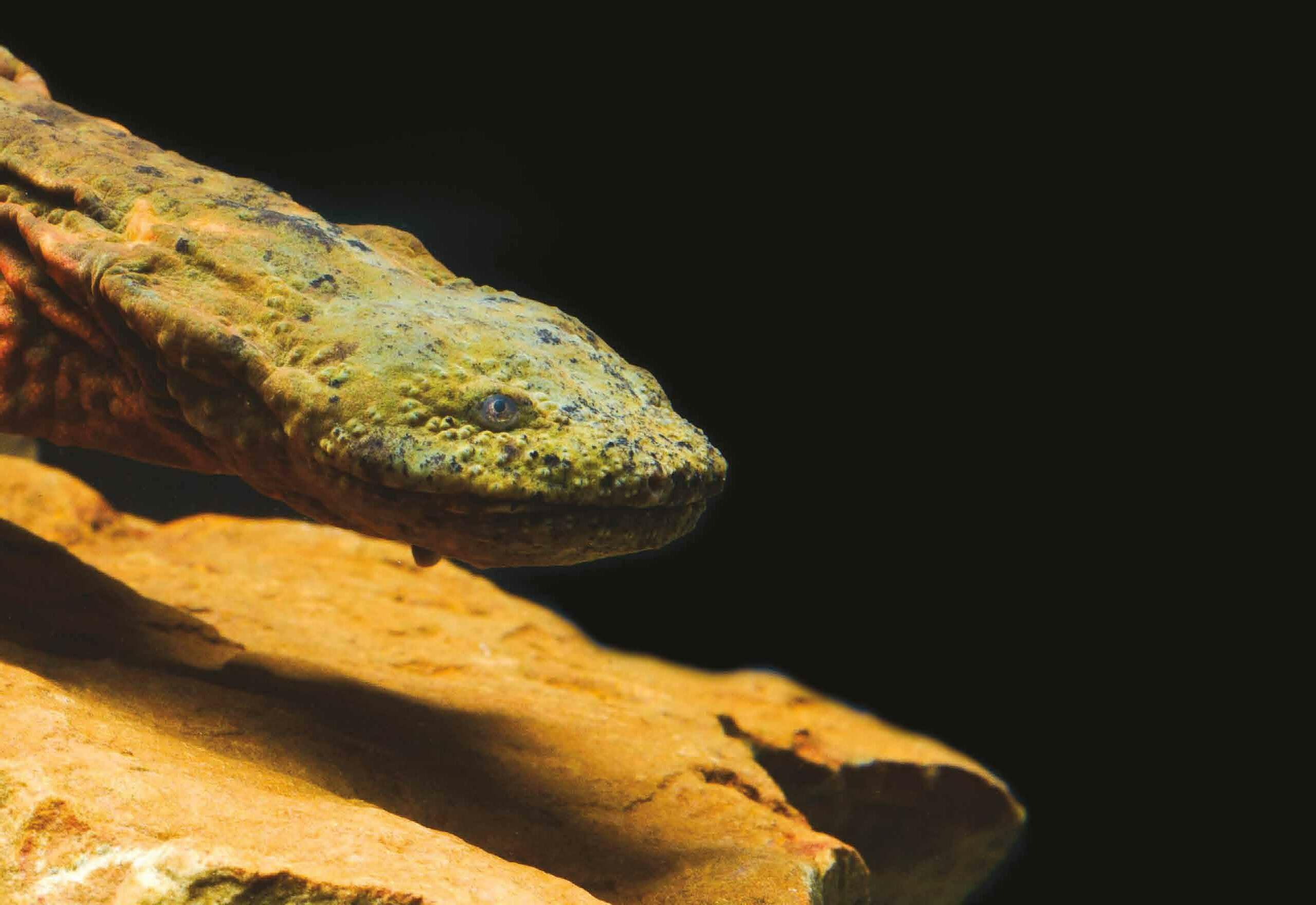
“The key to hellbender conservation was getting the hellbenders to reproduce at the Zoo so that we could support a population that would grow and eventually return to the wild,” said David Jarvis, Director of Life Support Systems. “We quickly realized water was a huge factor in this effort. As soon as we used reverse osmosis to provide the hellbenders with healthy water, we saw our
first successful reproduction at the Zoo.” Reverse osmosis is a process of filtering water that removes unwanted molecules, sediments and other contaminants on a molecular level.
Providing healthy water is not the same as providing clean water. Pure water, as in water that is almost entirely H2O, can be damaging to certain animals. Similarly, water that appears cloudy or has coloration can be perfectly healthy and comfortable. Hellbenders are a sensitive amphibian, and providing water that has been managed properly is important for their health.
Species are unique, and their differences translate into their habitat needs. To better understand how the Zoo manages this vital resource, let’s take a look at one of our most well-known water habitats: Sea Lion Sound!
WATER THAT IS ALMOST ENTIRELY H2O CAN BE DAMAGING TO CERTAIN ANIMALS. SIMILARLY, WATER THAT APPEARS CLOUDY OR HAS COLORATION CAN BE PERFECTLY HEALTHY
Sea Lion Sound is a saltwater environment containing nearly 250,000 gallons of water. This habitat cannot be drained every time it needs to be cleaned. Instead, the Life Support Systems team at the Zoo works around the clock to make sure this habitat stays safe, clean and comfortable for the animals.
On a typical day, there are multiple harbor seals and California sea lions in Sea Lion Landing, the spacious, year-round outdoor area of Sea Lion Sound. The animals live, eat, urinate and deficate in the pool. Dirty water that the animals have contaminated will leave the habitat and move through a sand filter, which removes a significant amount of contamination. This is the first stage of cleaning.
Once through these filters, some of the water will move into separate water streams, either for further sanitation through ozone treatment or for temperature control.
The ozone treatment is similar to what bottled water goes through for people! Temperature control is important because it ensures the animals are comfortable when living and playing in the pool. These water streams will join again with the main water column, and then the water is managed with a small (and safe) amount of chlorine.
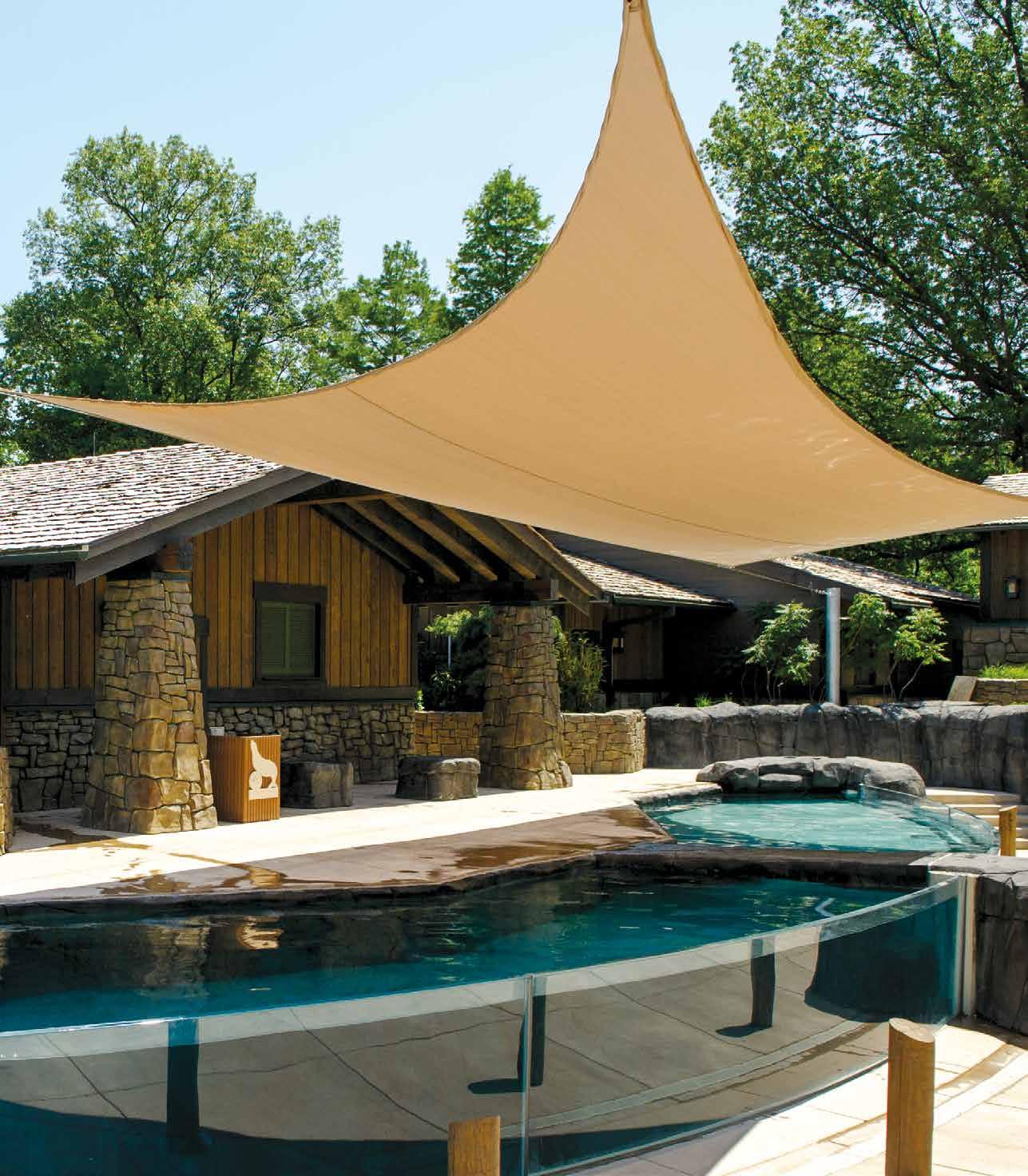
This is all accomplished before the water moves back into the habitat with the animals. Altogether, our systems at Sea Lion Sound filter roughly 5,000 gallons of water per minute! This cycle is constant, operating every minute of every day of every year, so the water is continuously filtering providing a clean and healthy space for our animals.
“Many people don’t realize how much goes into creating safe water habitats for animals like penguins, sea lions and polar bears. But that is part of our success. Our priority is making a safe home for the animals so that guests can focus on experiencing wildlife,” Jarvis said.
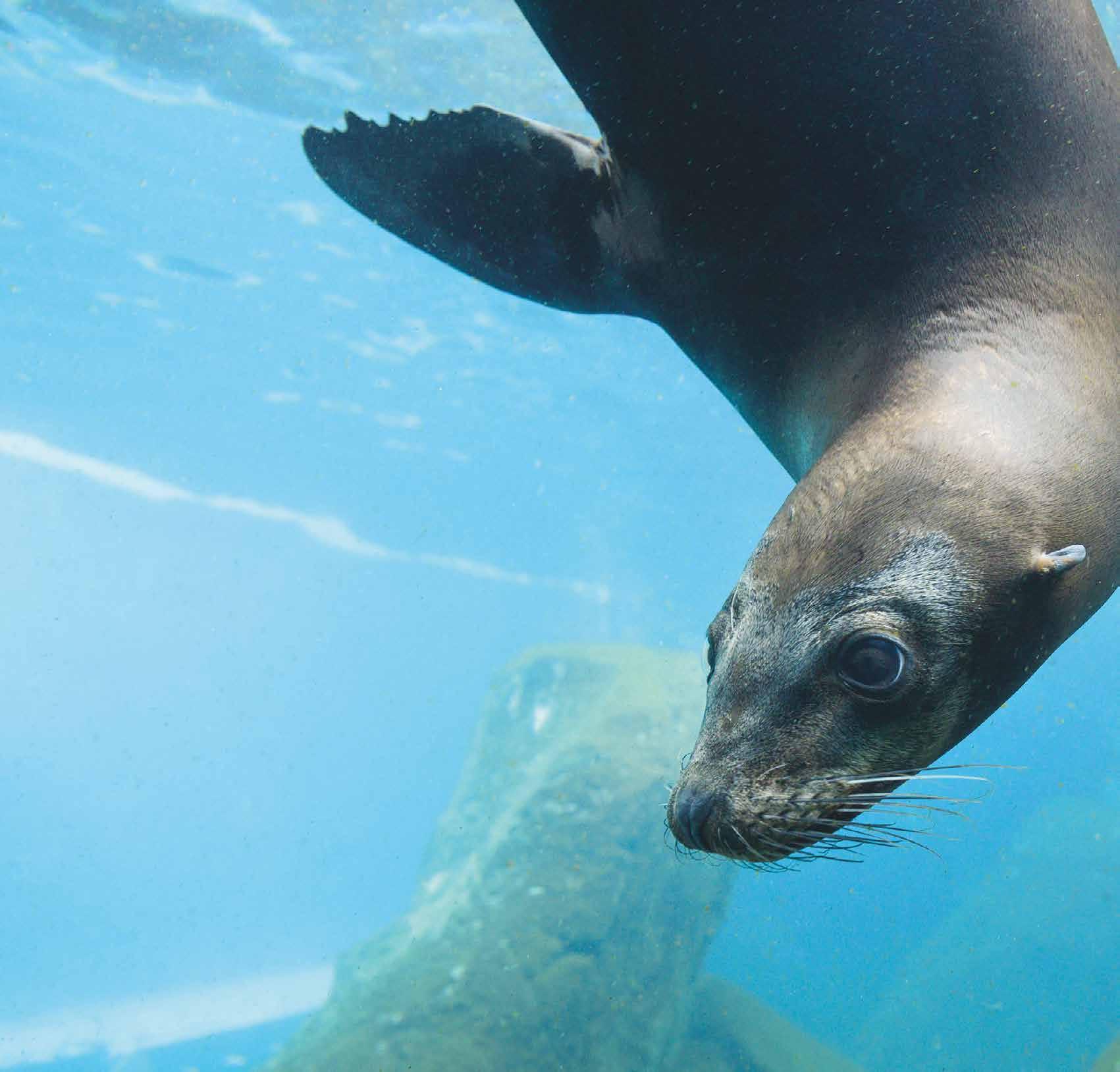
OUR PRIORITY IS MAKING A SAFE HOME FOR THE ANIMALS
Though essential, the care behind clean water is often unknown to Zoo guests. Managing and providing the necessary water to our habitats takes in-depth knowledge, resources and a team of experts. Just like many areas of Zoo and animal care, water management has changed over time to be more effective and efficient.
“Life support is an area that is continuously evolving. The use of technology and safer treatments, along with deepening knowledge in this field, has allowed our team at the Zoo to provide around-the-clock surveillance of the water in ways that were impossible a few decades ago,” Jarvis said.
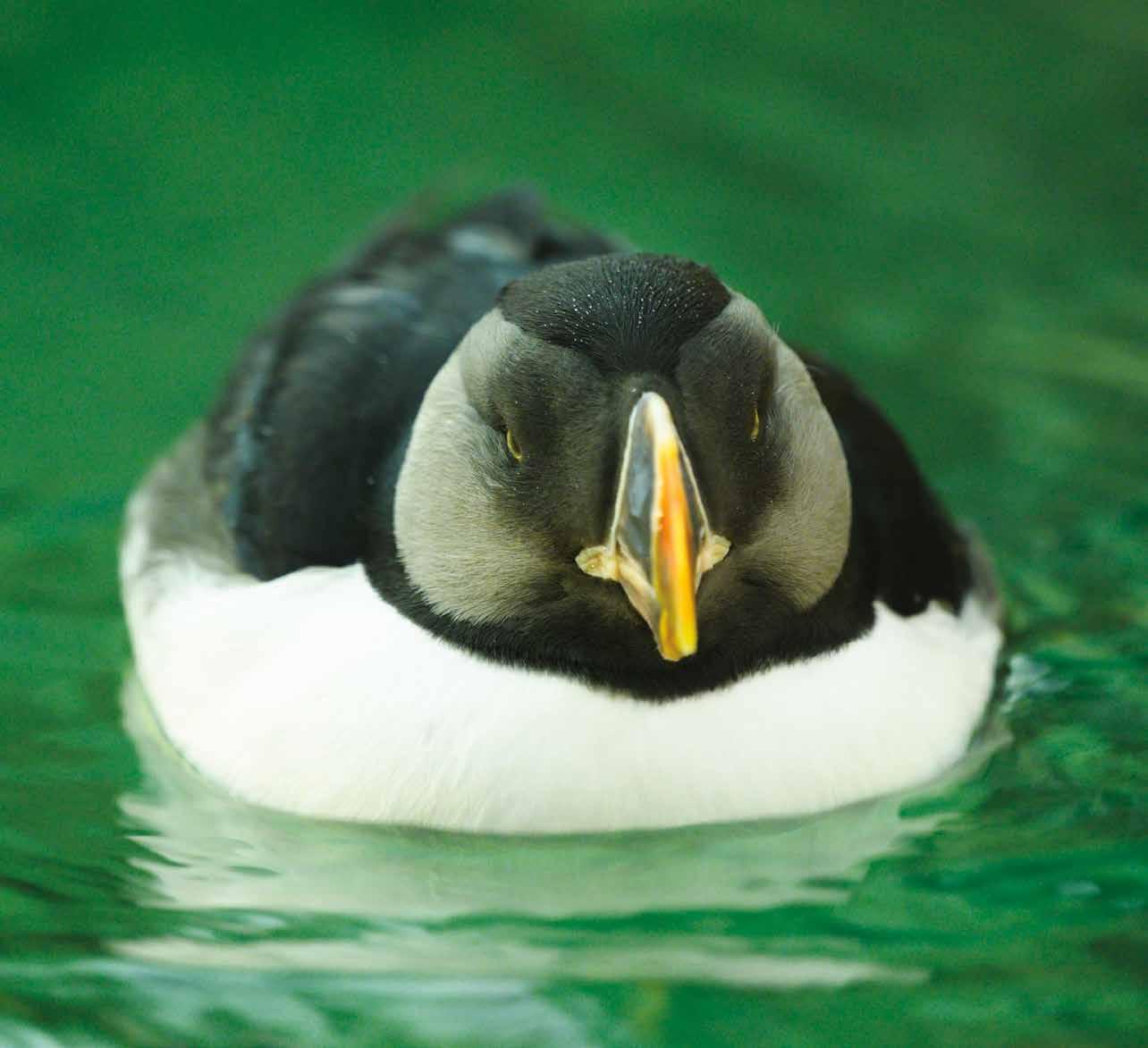
The world of zoos and water-based habitats has come a long way from the beginning, when the Toledo Zoo and Aquarium provided their hippos with a habitat similar to a fish tank.
“That is kind of where this all began; in 1986, the Toledo Zoo introduced their hippos to a habitat with over 350,000 gallons of filtered water. It can be seen as the beginning of zoos around the country looking at
large-sized water habitats for aquatic and semi-aquatic animals,” Jarvis said.
Since then, a number of technological developments have allowed zoos to care for more aquatic animals on a larger scale and with safer techniques.

Habitats like Polar Bear Point and Penguin & Puffin Coast are constantly monitored through automated systems for a number of data points that would have been difficult, if not impossible, to gather in the past. The water is monitored for temperature, pH levels, oxidative reductive potential and more. If anything seems off or dare we say, fishy then an alarm notifies someone on the Life Support Systems team. Furthermore, technology has allowed a significant amount of this monitoring to be achieved remotely, though the team is often at the Zoo and always prepared to go in case of an emergency.
Another key development is the focus on sustainability. “When you are working with hundreds of thousands of gallons of water, you are going to use a lot of water and a lot of electricity. But that doesn’t mean you can’t be focused
LIFE SUPPORT IS AN AREA THAT IS CONTINUOUSLY EVOLVING
on minimizing usage, conserving resources and recycling what you use. Sustainability is a huge priority for the Zoo, and that is connected to our work with water,” Jarvis said.
As filtration systems have developed over the years, the Zoo has been purposeful in adopting the newest technology. More efficient filters have led to a dramatic increase in the amount of water the Zoo can recycle and reuse in its aquatic habitats. Sea Lion Sound also was the first habitat at the Zoo to be designed with variable frequency drives (VFD) attached to its pumps. VFDs control how much energy is used to push
water into a habitat by evaluating what the habitat needs and then adjusting the speed of the motor accordingly.
It is believed this tool alone reduces the electricity used in the filtration systems at Sea Lion Sound by 20 to 30%.
“Sustainability does not stop with new exhibits,” Jarvis said. “We have refurbished older exhibits with more sustainable infrastructure as well. For example, once we saw the success of VFDs in Sea Lion Sound, we retrofitted Penguin & Puffin Coast. Resource responsibility is always a part of the choices we make when developing and managing these systems.”
Providing suitable water and managing the Life Support Systems are just one part of an intricate strategy that supports a healthy, safe and vibrant life for the animals at the Zoo. Without these systems, and without the ability to make available clean and healthy water, it would be impossible for zoos and aquariums to house and support a variety of wildlife that guests have come to love and enjoy. The hard work of the Life Support Systems team, along with new technology and the Zoo’s dedication to innovation and animal welfare, have been key factors in driving the Zoo to be a leader in our commitment to healthy water. n
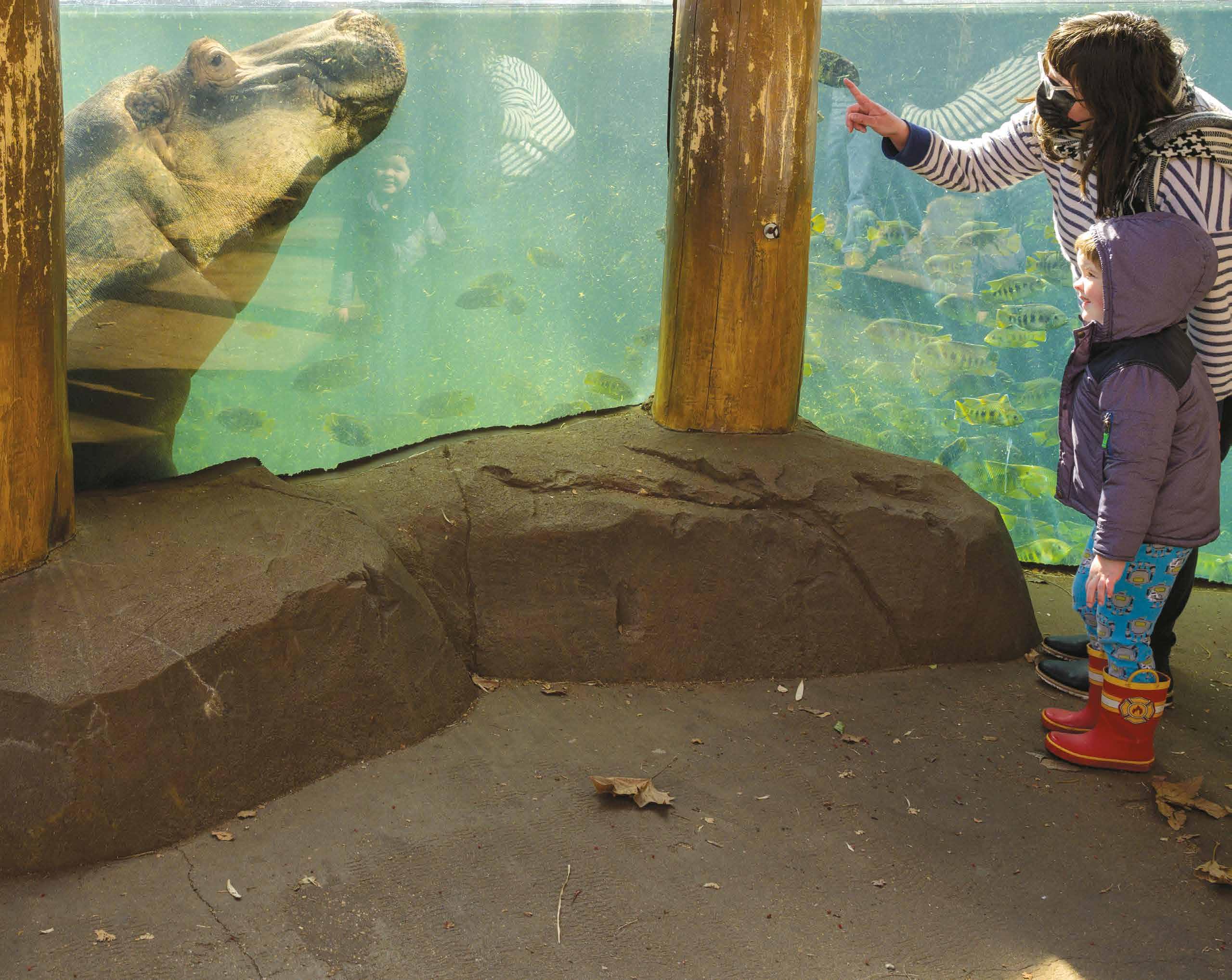
Losing an animal is never easy. Some members of our animal care team have worked with the same animals for their entire careers, and their loss can be devastating and emotionally draining. Although it is tough to say goodbye, animals leave an important legacy. An animal may provide our team with a wealth of information through its examination after death, called a necropsy.
“The knowledge we gain through necropsies helps advance several areas of animal science.”
The Saint Louis Zoo is one of a handful of zoos with its own veterinary pathologist, who oversees and conducts necropsy exams in all
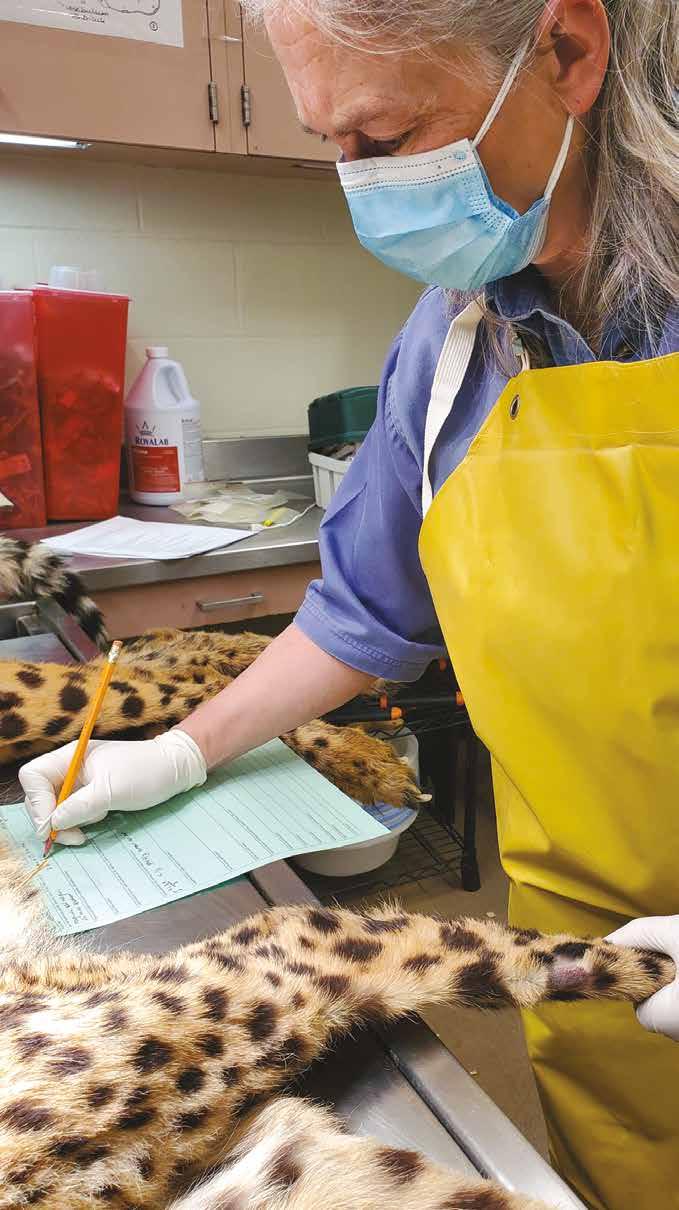
of the Zoo’s animals when they pass away. Although the primary purpose of a necropsy is to determine the cause of death of that individual, necropsies also provide many other learning opportunities. The knowledge we gain through necropsies helps advance several areas of animal science, so current and future animals at the Zoo and their caregivers can benefit from the lessons learned.
“Some of our best knowledge about animal care, health and disease comes from the unique expertise of veterinary pathologists,” said Chris Hanley, DVM, DACZM, Director of Animal Health.
Veterinary pathologist Mary Duncan, BVMS, Ph.D., DACVP, has worked at the Zoo for 25 years.
With decades of expertise and a career at the Saint Louis Zoo, Dr. Duncan has the benefit of knowing the animals during their lifetimes and the historical trends of animal care at the Zoo.
The physical examination of a deceased animal is only a part of a necropsy. Tissue samples are collected during an exam, and they undergo additional laboratory testing and examination under a microscope by a pathologist before the full story of animal health and disease can be understood.
The physical portion of necropsy exams are performed in a dedicated room at the Zoo’s Endangered Species Research Center & Veterinary Hospital. If an animal is too challenging to transport
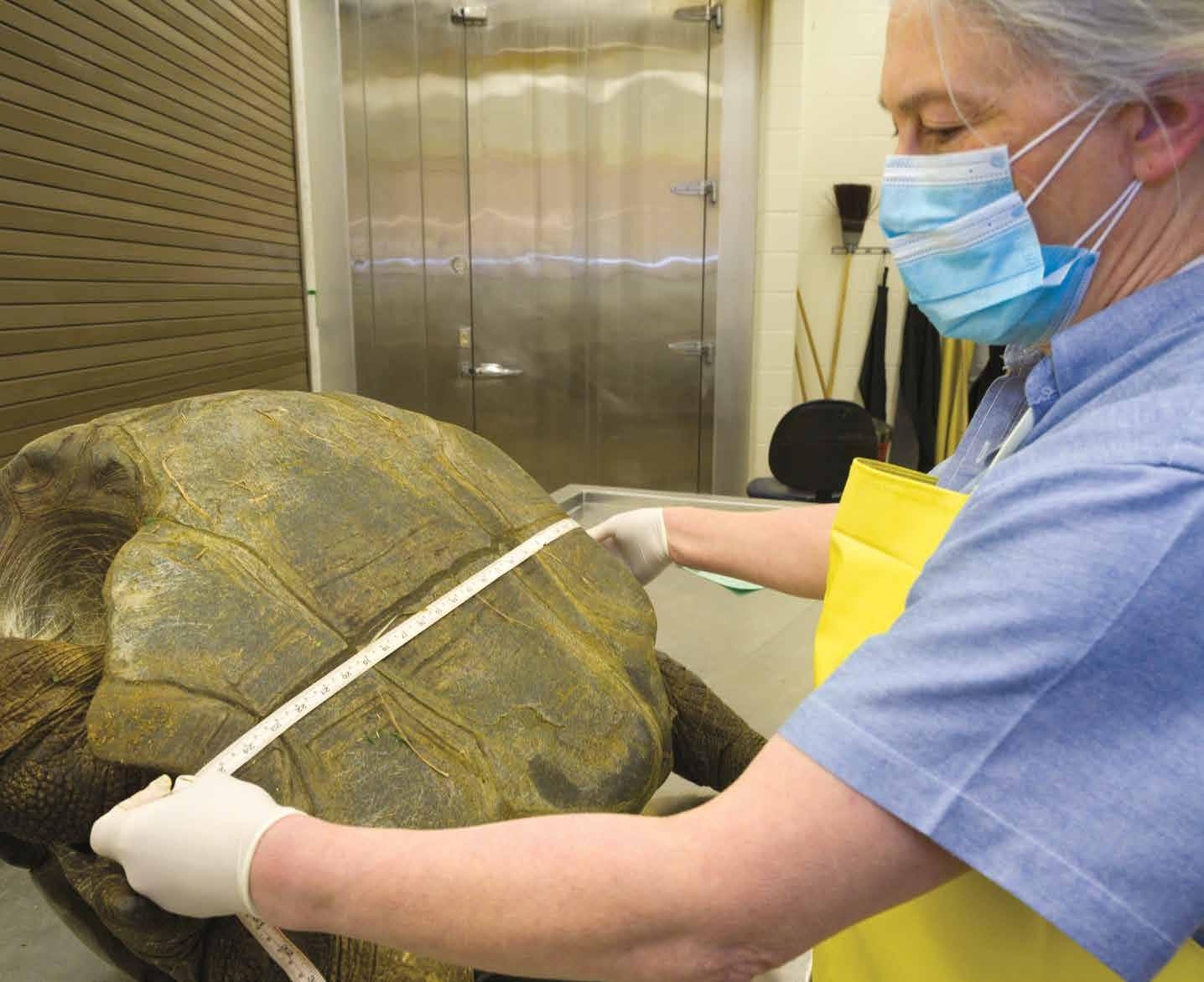
(such as elephants or rhinos), the postmortem exam is conducted in a private space near the site of death, with necessary biosecurity measures in place. An exam performed on a small animal may take up to an hour, while a larger animal, such as a big cat or ape, may take multiple hours as meticulous measurements are taken, samples are collected and the exam is thoroughly documented. Patience and attention to detail are important to ensure that the records can be used in the future, beyond identifying the immediate cause of death.
All animals that die at the Zoo undergo a necropsy exam, including native wild animals that die on campus.
“An essential aspect of a pathologist’s job is tracking disease trends and threats in real-time.”
“Necropsies on animals like raccoons are equally as important,” Dr. Duncan said. “Native wild animals could carry and transmit diseases, such as canine distemper, to Zoo animals. Now, when distemper or other diseases are identified in native wildlife, we can review the vaccination status of Zoo animals and provide any boosters needed.”
An essential aspect of a pathologist’s job is tracking disease trends and threats in real-time.
In addition to their medical expertise, veterinary pathologists rely on unique detective skills for following suspicious leads identified during an exam. Their expertise also relies on connections with other scientific experts: human pathologists, forensic scientists, molecular researchers, epidemiologists, infectious disease specialists and many other professionals.
“Our findings from necropsies — especially decades of necropsies — directly improve how we care for animals,” Dr. Hanley said. “For example, we know that gorillas are prone to heart disease.
Through years of gorilla necropsies, pathologists across the country have characterized specific trends in the most common type of heart disease affecting them. This knowledge resulted in veterinarians conducting proactive cardiology exams of gorillas under our care to look for these common pathologies before they cause a problem, and to start medications when indicated. Animals can’t tell us many things, but the pathologists can speak for them through these findings.”
The Saint Louis Zoo is a leader in the conservation of Western Asian mountain vipers, and Dr. Duncan has collected 20 years of lessons on the causes of death of these unique snakes. As a temperate species, an
important part of their biology is to undergo a period of brumation. During brumation, snakes slow down their metabolism to conserve energy during the winter months. This seasonal process is an important part of their life history, but it is also a time of high natural mortality due to the physiologic demands of brumating. Information gained from necropsy trends have led to proactive treatments to support the unique physiologic needs during brumation, and specifically hydration, to improve survival.
Though Dr. Duncan has years of experience handling necropsies and gaining scientific insights into why animals die, she said it’s remarkable to see the impact animals have on their caregivers. “Losing an animal can feel like losing part of the family ... sometimes I wait to do a necropsy until staff have had an opportunity to say goodbye,” she said.
“The lessons learned after an animals’ death could be considered the greatest legacy towards saving their species.”
Dr. Hanley added, “It’s always sad to lose animals, but the lessons we learn from the dead provide a foundation to better care for the living. The lessons learned after an animal’s death could be considered the greatest legacy towards saving their species.” n
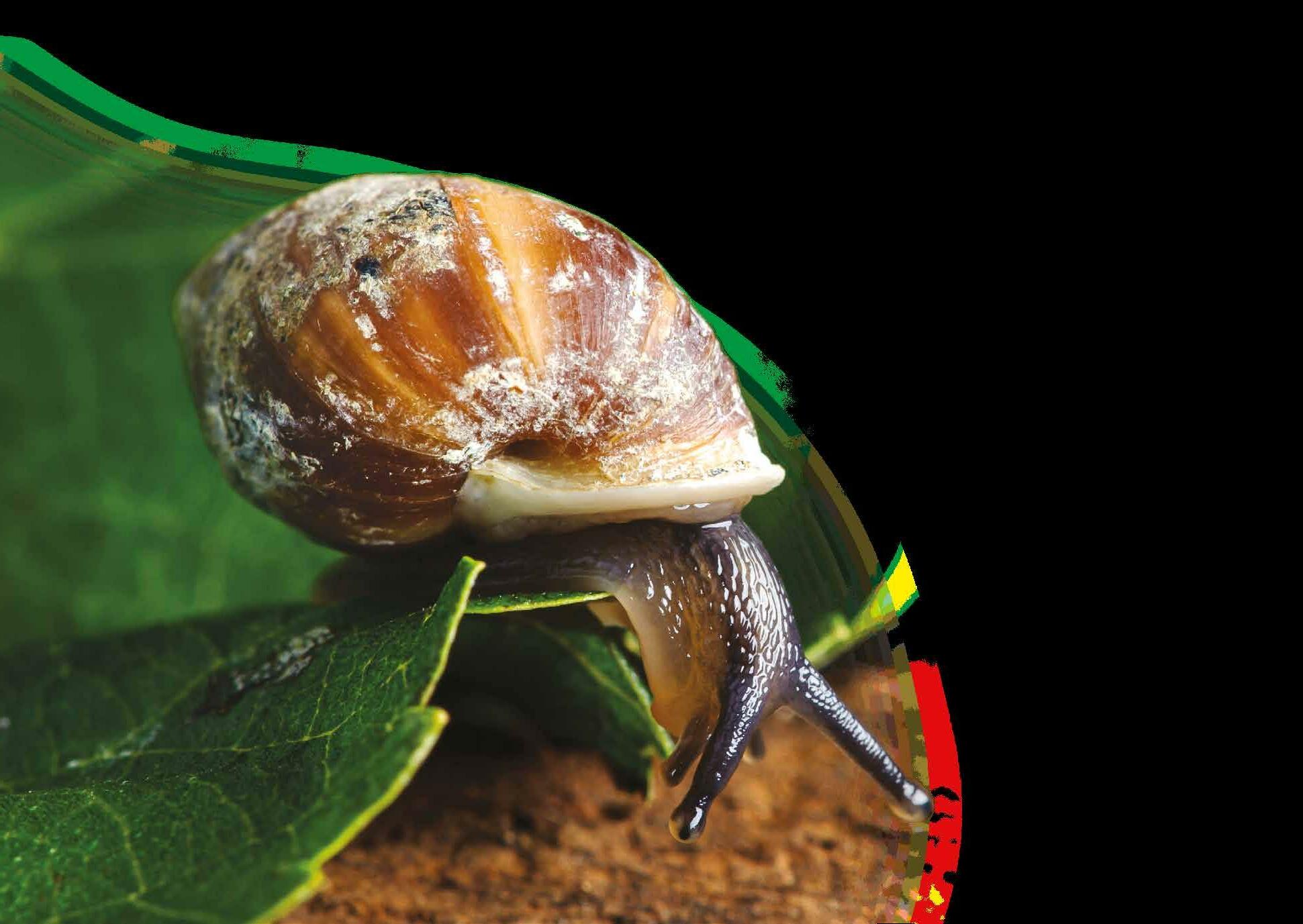 By Glenn Frei, Invertebrate Keeper
By Glenn Frei, Invertebrate Keeper
When guests visit the Zoo, most aren’t swarming the Bayer Insectarium to observe snails. Most wouldn’t think twice about the task of keeping thousands of snails healthy and thriving — much less, consider it an exciting job. However, most haven’t met the Partula snails — and haven’t a clue how significant these beautiful gastropods (snails) are!
Measuring less than an inch, this species was equipped with some cool and curious traits that made them wildly successful in their home range — until non-native species arrived. Now, extinct in the wild, this species has thrived at the Saint Louis Zoo for more than 30 years. During this time, multiple tens of thousands of snails have called the back rooms of the Insectarium home.
While earthworms are significant to the ecosystems of mainlands as decomposers, they are not typically
found in island ecosystems. This is where snails step up to the plate. Where earthworms are absent, snails clean up nature’s grunge and trash, converting it into nutrients for the inhabitants. This type of environment is difficult to imitate while simultaneously tracking the population’s overall health. Instead of a natural replication of their native environment where they would be difficult to monitor, the snails are raised in clear containers lined with paper towels. This ensures that every snail — even the tiny, one-millimeter babies — can be easily observed and tended to.
With snails serving as natural garbage disposals, it is difficult to determine what their native, wild diets would consist of. When these snails were first collected in conservation efforts put forth by a collaboration of zoos and universities, these institutions developed a diet that is still used today, with minor adjustments over the years. A mixture consisting of ground-up nettle, oats or trout chow, a calcium source, and other vitamins and ingredients, is supplied in powder form by the Zoo’s Animal Nutrition Department. Before serving
up this delicacy, the powder is mixed with a bit of water and transforms into a “snail pesto” of sorts. Twice a week, this paste is spread on the walls of a fresh habitat. The snails are transferred into this new home and lightly misted to increase humidity. This rudimentary spa treatment seems to invigorate their senses and they begin gliding their way through this new environment, scraping at the food with their radula — i.e., snail teeth.
While keeping the snails fed and alive is a significant part of my day-to-day tasks, I concurrently serve as the Species Survival Coordinator and Studbook Keeper. While the titles may raise some eyebrows outside of the zoo/conservation realm, they are positions that every Species Survival Plan has (a SSP is a population management and conservation program for a specific species of wildlife). In this role, one documents all of the males and females of the species to track genealogies and make recommendations for breeding pairings to ensure the long-term sustainability of zoo populations.
At the end of each month, I create a census, counting every snail in our population and watching for trends. With more than 3,000 animals at the Insectarium, this is by far the most tedious part of being a snail keeper. Losing count halfway through a container can cause one to dream of early retirement.
While this task is monotonous, it is critical — and the Partula snail likes to throw a curveball (or two) into the process. One of the snails’ oddities that make this type of tracking almost impossible is that they are hermaphroditic, meaning both male and female. In addition, they can selffertilize and reproduce without a mate. At one European zoo, the Partula population dropped to a single snail. At last check, they were up to 1,200 snails. While this incredible adaptation makes this species exceptionally resilient, it makes it almost impossible
to track genetics except as a group. Instead of tracking individuals, we monitor group lineages and the life stages of each snail: newborn, juvenile, sub-adult and adult. While unconventional compared to most SSPs, this has become an incredibly helpful tool in caring for the species.
While the day-to-day care of Partula snails is not an overly complex process, exceptional observation skills are critical in recognizing the nearimperceptible changes in the snails’ behavior and health. Naturally decent eyesight (or a good optometrist) is
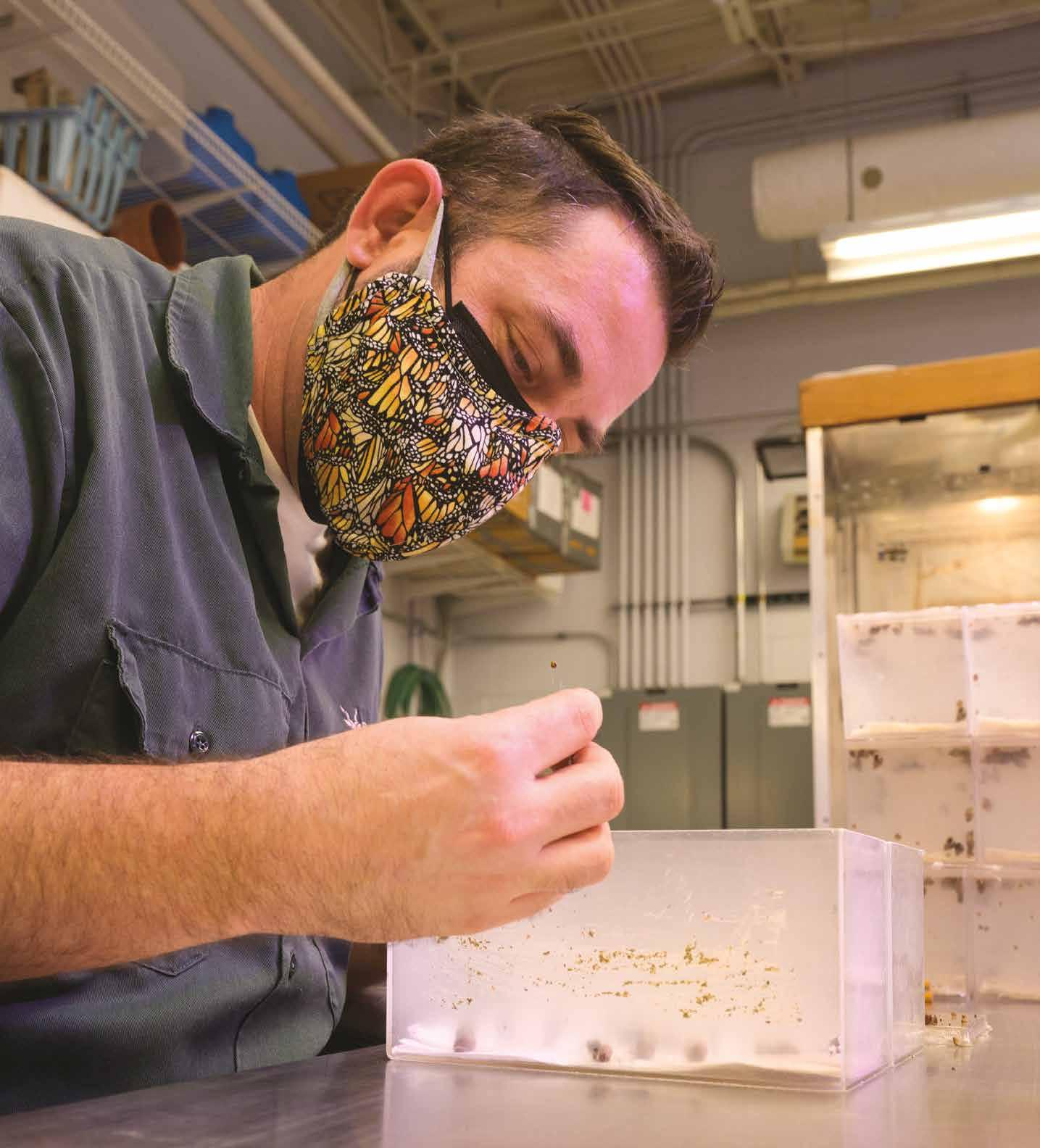
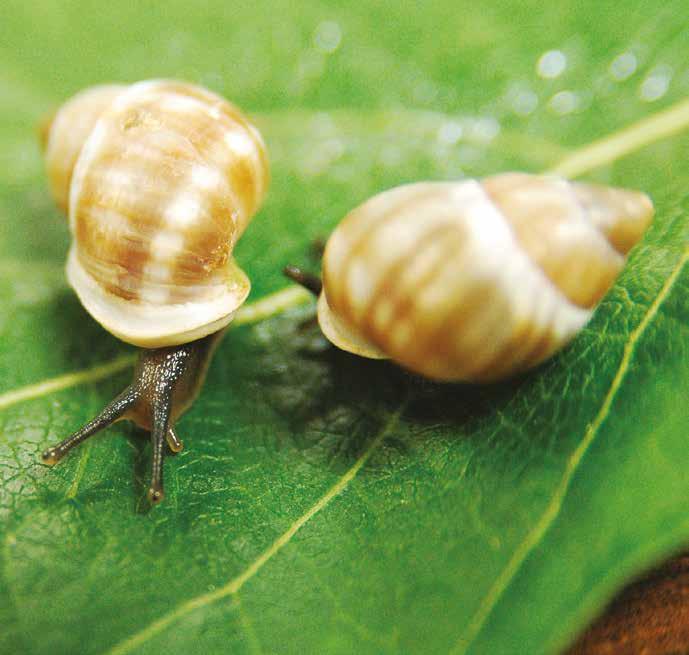

highly beneficial, as the snails fail to communicate in a straightforward or obvious manner.
After caring for these creatures for the last 18 years, I like to think of the snails as minute creatures with little campers on their backs, puttering their way through life’s adventures. They are in no hurry to get where they are going, but they enjoy what is in front of them and are hopeful that — with the care their keepers provide them — they will one day return to the peaceful valleys of Tahiti, with a story or two to share. n
Mother’s Day Brunch May 8, 2022; Seatings at 8:30 a.m., 10:30 a.m. and 12:30 p.m. at McDonnell Center at River Camp
which features an 811-seat amphitheater for seasonal shows. Zoo members: Included in member/premium member tickets. Non-members: $3.95/person. Children under age 2 are free.
Stingrays at Caribbean Cove presented by SSM Health April 8 – October 31, 2022; Open Daily
Guests can enjoy a hands-on opportunity to touch and feed these gentle ocean creatures. Zoo members: included in premium member tickets. Non-members: $3.95/person. Children under age 2 are free. Feeding is $1. Group rate for 15 or more is $3 per person.
Enrichment Eggstravaganza presented by Kinder Joy ® April 16-17, 2022; 9 a.m. – 4 p.m.
Watch in delight as several Zoo animals enjoy enrichment “egg hunt” activities. Free.
April 30, 2022; 7 a.m. – Noon
Start your day off right with a relaxing yoga session, led by a certified instructor, amid the lush landscape at Historic Hill. Afterward, enjoy brunch at the nearby Event Tent, which includes one drink ticket and a custom-designed water bottle. Zoo members: $35. Non-members: $45. More information: (314) 646-4771, option 2. Email invitation to follow.
Zoo Friends Day May 6, 2022; 3 – 8 p.m.

Zoo Friends Day is the annual member event to kick off the new season at the Zoo. Includes free parking and admission to Zoo attractions. More information: (314) 646-4771, option 2. Formal invitation and email to follow.
Treat Mom to brunch at the Zoo, complete with champagne. The meal includes breakfast fare, desserts and more. Adults 21+ receive two drink tickets for beer, wine or champagne. Parking not included. For pricing, reservations and other information: (314) 646-4897.
Jungle Boogie presented by Mid America Chevy Dealers Fridays, May 13 – August 12, 2022; 4-7 p.m. (Exhibits and attractions open until 7 p.m.)
Bring the whole family for an evening concert in the center of the Zoo. Sponsored by Mid America Chevy Dealers, Coca-Cola and Prairie Farms Dairy. Free. No concert on June 17.
From May 13 through August 14, the Zoo will be open from 8 a.m. to 7 p.m. on Fridays and Saturdays, and from 8 a.m. to 5 p.m. on Sundays through Thursdays. (Zoo will close at 3 p.m. on Friday, June 17, due to A Zoo Ado, the Zoo’s major fundraiser.)
St. Louis Children’s Hospital Make Tracks Through the Zoo May 22, 2022
Back once again for an in-person race! Run the 5K at the Zoo or virtually. Sponsored by St. Louis Children’s Hospital, Mid America Chevy Dealers, Heartland Coca-Cola Bottling Company, Prairie Farms Dairy, Big River Race Management and KSLZ Z107.7 Registration fee applies.
Night at the Zoo presented by Mercy May 25, June 22 and July 27, 2022; 5-8:30 p.m.
Chill out at an evening at the Zoo perfect for a date night! As you roam around, enjoy music from a DJ and sip some spirits; two drink tickets are included in admission. And be sure to check out the Mary Ann Lee Conservation Carousel, Stingrays at Caribbean Cove presented by SSM Health and the Emerson Zooline Railroad. Sponsored by Mercy, Coca-Cola and Mid America Chevy Dealers. Zoo members: $25. Non-members: $30. ZYP members may use their free tickets. More information: (314) 646-4771, option 2. Email invitation to follow.
A Zoo Ado June 17, 2022; 7 p.m. – Midnight
This creative, casual-dress party benefits the Saint Louis Zoo. Evening includes small plates, an open bar and live music. Sponsored by U.S. Bank, World Wide Technology and Mid America Chevy Dealers. Tickets required. Zoo members: $85. Non-members: $100. $2,000 for Leaping Lemur table of 10. More information: (314) 646-4771, option 2. Formal invitation to follow.

Pollinator Dinner June 21, 2022; 6-9 p.m.
Join us for a special Pollinator Dinner
Regular Hours: 9 a.m. 5 p.m.
Summer Hours (May 13 – August 14):
On Sundays through Thursdays, the Zoo is open from 8 a.m. to 5 p.m. On Fridays and Saturdays, and on select holiday weekends (May 27-30 and September 3-5), the Zoo is open from 8 a.m. to 7 p.m. The Zoo will close at 3 p.m. on June 17.
Please check back to our website at stlzoo.org for more event information.




Ahhh, spring in St. Louis! It is a beautiful time, and we are ready to get outdoors after a long, cold winter. Our calendars tell us that the official first day of spring is March 20, but how do animals that don’t have calendars know spring is coming? They use several of the same clues that we look for, too!
After the spring equinox, the days get longer, meaning we see more sunshine each day. Animals notice that as well. Also, the increasing temperatures warm up the ground, which is a sign to animals that hibernate underground to wake up and come out. Plants sense the ground warming, too, and they start to emerge. You also may see some animals molting, which means losing their thick winter fur or feathers. This is very similar to how we switch from wearing thick winter coats to lightweight jackets!
Animals that migrated south are starting to return, and we will see

many birds passing through St. Louis. Spring is a great time to get out the hummingbird feeders for our small ruby-throated friends looking for a snack. And don’t forget a variety of seeds, suet and fruit for our other feathered friends!

Pollinators like bees and butterflies are looking for delicious pollen, and you can help them by planting native plants in your garden or yard. Visit stlzoo.org/pollinators for more information, or ask for help at a local nursery.


In addition to feeders and plants around our homes, spring is a great time to get out and explore! Stop and smell some of those emerging flowers. Listen for different birds and frogs that are singing. You can be certified as a citizen scientist through FrogWatch USA by learning to identify frog species by their call and reporting it to a national database. Learn more at stlzoo.org/frogwatch.
Also, with the spring rains, it is a great time to look for a variety of animal tracks in the mud. If you need some inspiration to get outside, visit stlzoo.imagencloud.com for some resources like nature scavenger hunts or nature journaling prompts to help you in your outdoor adventures.
Happy spring! n

In his nearly 20 years of leadership, Jeffrey P. Bonner, Ph.D., President Emeritus, has taken the Saint Louis Zoo to a new level in its conservation efforts, educational impact and guest experiences. From establishing a $100 million endowment to benefit the Zoo, to leading the charge to acquire the land for the Saint Louis Zoo WildCare Park, to advocating for animals and communities around the world that are the most vulnerable, Dr. Bonner’s legacy will continue long after his retirement.

To celebrate the legacy of Dr. Bonner and to honor his lifelong dedication to the natural world, the Zoo created the Jeffrey P. Bonner, Ph.D., Conservation Fund within the endowment to benefit the Zoo’s conservation efforts through the Saint Louis Zoo WildCare Institute. At the same time, we humbly asked you, our best Zoo supporters,
to consider a gift to celebrate this new fund. And boy, did you deliver!
Dr. Bonner’s passionate dedication to the natural world and the conservation of endangered species and their habitats has ensured that his legacy will continue at the Zoo long after his retirement. We are honored to celebrate the career of Dr. Bonner, and even more honored to recognize all of the donors to this special fund. Without you, his legacy would not be as incredible and life-changing as it is now expected to be for conservation efforts at the Zoo and in the wild.

We would like to personally thank every donor to the Jeffrey P. Bonner, Ph.D., Conservation Fund. The donor listing on the following page reflects individuals, foundations and corporations at the time of commitment to the Saint Louis Zoo Association. n

Trish & Michael Abbene
Ed & Judy Adams
Marcia & Joe Ambrose
Ms. Linda E. Babb
Jacques & Nancy Baenziger
Mrs. Mary Randolph Ballinger
Mr. & Mrs.† Clarence C. Barksdale
Mr. & Mrs. Ted W. Beaty
Mr. & Mrs. Patrick Behan, Sr. Alex & Cynthia Berger
Lee Berger
Mr. & Mrs. James Berges
Elizabeth A. Biddick
Candace Bingham
Marion & Van-Lear † Black
Barbara Bowyer
Marie & John Brauer
Ms. Cassandra Brown-Ray & Mr. Quentin Ray
Ralph & Chris Burgess
Dr. & Mrs. Edmond Cabbabe
Robert & Connie Carr
Ann L. Case
Christine & David Chadwick
Lucia M. & Ronald C. Clifton
Mr. & Mrs. Parker B. Condie, Sr. James & Joan Conway
Paul & Suzy Davis
Ms. Carol J. Demsky
Dustin, Jennifer, Caleb & Sam Deschamp
Edison Family Foundation
Mrs. Barbara & Dr. Gerald Fine
Frank & Martha Fischer
June & Charles Gallagher
Mr. David R. Ganz
Dr. & Mrs. Ted Garrett
Ms. Antonia Goelz
Jan & Rand Goldstein
Tracy C. Green
Mr. & Mrs. Gary A. Halls
Mrs. Richard A. Hamilton
Will & Susan Harbaugh
Bill & Cathy Hardebeck
David & Kate Hatfield
Dave & Kathy Hawkins
William & Michelle Hawkins
Eleanor B. Hecht
List as of February 14, 2022 †denotes deceased
Jay† & Carolyn Henges
Ms. Shelli Herman
Milton Hieken & Barbara Barenholtz
Lynne & Ed Higgins
Mr. Richard M. Hills Charlie & Marilyn Hoessle
Ann Hogan
Cynthia & Denny Holter
Alois C. & Stephanie A. Hoog Linda & Jesse Hunter
Jeffrey L. Huntington
Mr. & Mrs. Robert L. Huskey
Edward & Margaret Imo
Mr. & Mrs. Kenneth A. Johnson
Mr. & Mrs. Stephen Jones
Norma Deen Juracsik
Chris & Beth Kemph
Steven B. King
Mr. Patrick J. Kleaver Mark & Virginia Koors
Nancy & Ken Kranzberg Robin & Mike Kraujalis Mr. & Mrs. Stuart J. Krawll Gary & Patricia Krosch Abigail R. Lambert F. Holmes Lamoreux & Ann Tretter Mr.† & Mrs. Clinton Lane, Jr. Mrs. Ann T. Liberman
Carol B. Loeb
Paul & Jan Loewenstein
Mr.† & Mrs. William C. Lortz Mrs. Carolyn Losos Rosalyn & Charles Lowenhaupt Drs. Dan & Susan Luedke
Brock & Nancy† Lutz
Kenneth C. & Amy M. Lynch
Mr. Jordan S. Mandel
Alicia S. McDonnell
Mr. & Mrs. James S. McDonnell III Gene & Donna McMahon
Randy J. & Cathy M. Meisner
Bob Merz & Melissa Miller
Katie Meyers
Richard & Verla Mitchell
Carolyn Moll
Patrick & Elizabeth Moore
Mr. & Mrs. David B. Mueller
Stanley J. Niemann Jay & Lisa Nouss
James & Marcia Nusz Chonda Nwamu
Marjorie Olfe
Joseph & Katrina Pfeiffer
Mr.† & Mrs. James T. Poor Linda Weast Reifschneider Joseph & Stefanie Ricca Peggy & Jerry Ritter
Cheryl L. Rossman & Jim Roche
Andrea Powers Schankman
The Steven F. Schankman Family Judy & Rick Schiff
Dr. Charles & Dr. Elizabeth Schmitz
Dr. & Mrs. Sherman Silber
Mr. & Mrs. William T. Skaggs
The Donald Slavik Family Foundation Dudley Teel & Lisa Smith-Teel
Mr. & Mrs. John R. Sondag
Sanford & Gloria Spitzer
Lori A. Sullivan & G. Todd Rogan Daphne H. Sumner
Mr. & Mrs. Grenville G. Sutcliffe Mr. & Mrs. Jack E. Thomas
Dr. Robert M. & Mrs. Mary C. Voelker Ms. Beatrice Busch-von Gontard Lee R. Wallace Mrs. Lois M. Walsh
Mr. & Mrs. J. R. Walters Deborah Werner
Ginnie Westmoreland & Jim Dryden
Mrs. Constance V. R. White
Mark & Deborah Wilhelm Libby Yunger
Somali wild ass

Wendy Knudsen Farrell and her late husband, George Farrell, had a lifelong love affair not only with each other, but also with animals. George fancied turtles most of all. He marveled at their leisurely and steady pace, their strength and singularity in carrying their homes on their backs, and their timeless existence as ancient beings living in a modern world.
“George loved creatures, and turtles held a special place in his heart,” said Wendy. “From regularly feeding apples and grapes to his turtle buddy, ‘Rusty,’ who lives under our front porch, to regularly stopping his car to move an ambling turtle to safety, George showed his love and respect for these creatures constantly.”

Several years ago, George and Wendy were at the White Oak Conservation Center in Florida, where they met Sharon Deem,
DVM, Ph.D., DACZM, Director of the Saint Louis Zoo Institute for Conservation Medicine (ICM). They connected with Dr. Deem instantly and were taken by the important research she conducts on turtles and tortoises.
When the opportunity arose, it was only natural that Wendy chose to honor George’s memory by supporting ICM’s research. The George F. Farrell Wildlife Conservation
and

“I am honored to establish this fund in memory of my most beloved so that he can play a part in helping these ancient beings continue to survive and thrive,” Wendy said. Thanks to George’s love of turtles and Wendy’s love for George, the future of conservation efforts for these animals is much brighter. n

The Saint Louis Zoo is proud to partner with Stone Hill Winery to bring awareness to the hellbender, the official endangered species of the state of Missouri and one of the largest salamanders in the world. A portion of the proceeds from each bottle of their Ozark Hellbender red blend sold is donated to the Saint Louis Zoo and hellbender conservation efforts. Together, we have raised $40,000 so far!
Stone Hill Winery celebrates its 175th anniversary this year, continuing its legacy of being family-owned and operated in Hermann, Missouri. It is owned by the Held family — their love for hellbenders inspired the name of their Ozark Hellbender wine, which recently won Best of Class Semi-Dry Red in the 2021 Missouri Wine Competition.
“Our region is very lucky to have a world-class conservation institution
impacting global and local animals and ecosystems,” said Nathan Held, Director of Strategy at Stone Hill Winery. “For years, we have been enamored by Missouri’s unique Ozark hellbenders. It means a lot to us to help support this special creature that calls our state home with proceeds from our Ozark Hellbender wine. Without the Saint Louis Zoo, our state’s biodiversity would be far less rich, and the Ozark hellbender may have gone extinct.”
Lovingly referred to as “snot otters,” hellbenders are native to the Ozark aquatic ecosystem of southern Missouri and northern Arkansas, but their populations in the wild have declined by more than 70% over the last 40 years due to human-driven habitat loss and pollution.
The story of the hellbender and the Zoo spans over 20 years

and is filled with immense success for the conservation community. The Zoo’s recently renamed Ron and Karen Goellner Center for Hellbender Conservation, part of the Saint Louis Zoo WildCare Institute, made history when the first zoo-bred hellbenders were hatched in the Herpetarium in November 2011.
As of last year, over 12,000 hellbenders have hatched and 9,400 have been released into the wild with the support of the Missouri Department of Conservation, U.S. Fish and Wildlife Service, and Stone Hill Winery.
To purchase Stone Hill Winery’s Ozark Hellbender wine and support hellbender conservation efforts, you can visit Stone Hill Winery in Hermann, Missouri, or find the wine at metro-area grocery stores. n

The Saint Louis Zoo is extremely fortunate to have the support of more than 1,300 generous individuals, foundations and corporations through the Marlin Perkins Society. We welcome our newest members to the Society and thank them for joining this wonderful group of supporters. To our current members who have increased their financial support, we are pleased to recognize you as well. We are grateful for your commitment to our mission.
New Marlin Perkins Society Members
November 1, 2021 – January 31, 2022
Anonymous (3)
Annika & Joseph Bartek
Rudy & Sandy Beck
Katherine Sutcliffe Becker & Tyson Becker
Carol Benoist
Rachel & Matthew Broom
David & Janet Camarota
Sumi & R. Chuck Chakraverty
Nancy H. Child
Robyn Combs
Cristi & Jimi Cook
Marcy & Rick Cornfeld
Dr. Gilbert & Mrs. Laura-Jean Cyr
John R. Drew
Roy E. Evers
Dennis & Helen Fuller
Patricia & Timothy Goldsbury
Karl & Ava Griffith
Susan & Bryan Hatfield
J. Christopher Hesse, J.D. Amelia & Justin Hummel
Robert & Ilene Jenkins
Anne G. & Harry J. Leschen
Julie & Stephen Lilly
Erin & Jamie Moses
Pravina Pindoria & Amit Kothari
Mrs. Shirley Rector
Carol Rosenkranz
Chance Ruppel & Lori Ashmore-Ruppel
David, Victoria, & Hendrix Samuels
Matthew & Jennifer Schrimpf
John N. Schoenfeldt
Shannon & Curtis Searcy
Brian Siebert & Rachel D’Souza Siebert
Smail Family Foundation in Memory of Anne Johnson East
The Smalley Family
James Tobin & Virginia Heagney
Joanna Eckhoff Tschudy
Lottie H. & A.J. Wade
Robert Wetzel & Brenda Mainer
Luke Yamnitz
Michelle & Joe Zweifel
Current Marlin Perkins Society Members Who Have Increased Support
November 1, 2021 – January 31, 2022
Pat Ahrens
Anonymous
Gary & Catherine Bieg (10)
Mr.† & Mrs. Van-Lear Black III (25) Terry & Susan Block (15)
Kristy Runk Bryan & Dr. Kenneth A. Hacker
Ms. Mary Campbell (10)
Brian & Jessica Cissell Mary Ellen Cotsworth & Bill Siedhoff (10) Nettie Orthwein Dodge
Joe & Lindsey Doyle Richard & Cheryl Emery
Dr. Robert F. & Rosemary Emnett Matthew & Angela Gabel
Andy & Nancee Glaser (10)
Michelle Glass
Ed & Joanne† Goedeker (10) Mr. & Mrs. Joseph L. Goltzman (15) Mrs. Sandra M. Greenberg (15) Mr. & Mrs. Gerald Grindler (20) Mark & Davida Grindstaff (10) Sidney & Bobbi Guller Family Foundation (10)
Bruce Harris (10)
Whitney† & Anna Harris (25) Eugene & Lori Harris
Marcie Harris-Hayes & Michael Hayes
Marjorie Ivey (30)
The Katz/Smith Family (15) Ms. Christina M. Kelly
Salvatrice & John Kemper
Chris & Beth Kemph Roger & Fran Koch
Peter & Susan† Krombach (20)
Diane & Tom Lawrence (10) Rich & Kathy Lintz (10)
Paul Lorenz & Julie Coulter Donn & Michele Lux
Brian N. Manley
Dr.† & Mrs. Marshall S. Manne (15)
Mr. & Mrs. Charles N. McAlpin (10) Anne & John McDonnell (20)
Jim & Jennifer McGrath
Jim & Susan McHugh Ms. Lisa Mechele
Jeremy Nighohossian Mrs. Ginny Orthwein
Drs. John Park & Katherine Shiue Neal & Ann Perryman
Gordon & Susie Philpott (15)
James & Michelle Probert Maggie & Dan Sartore James & Judith Schloeman Bill & Sandy Schweickhart
Barbara B. & David R. Smith
William N. Stevens
Olivia Tarlow Tarlow Family Foundation Jessica & Aaron Tarlow
The Tharpe Family Foundation
Mr.† & Mrs. Robert P. Tschudy (20) Steve Tschudy (20)
Andrea & Peter Van Cleve (20) Curtis & Mindy Voelkel (20)
The Brian Wickenhauser Family William & Shannon Willhite Craig & Donna Wood (15)
†denotes deceased
(10) denotes member for at least 10 years (15) denotes member for at least 15 years (20) denotes member for at least 20 years (25) denotes member for at least 25 years (30) denotes member for at least 30 years
Please contact the Development Office at (314) 646-4859 if you:
• Would like information on how you can join or increase your support to the Marlin Perkins Society
• Discover a discrepancy or have a question (the Zoo makes every effort to acknowledge all gifts and to maintain accurate records)
The following list represents new gifts and pledges made to the Saint Louis Zoo Association from November 1, 2021, to January 31, 2022. Donors are listed in the category of their most recent giving to the Saint Louis Zoo.
Major Gifts
$5,000,000 and above
The Bellwether Foundation
$999,999 – $750,000
Estate of Carol S. Gronau
$749,999 – $500,000
Anonymous Judith & Nicholas Kouchoukos
$499,999 – $250,000 Wendy Knudsen
$249,999 – $100,000
Dana Brown Charitable Trust Foundation
Estate of Patricia Hodshire Ralph & Brenda† Hoffman Karen & John Meara
The Donald Slavik Family Foundation
Special Gifts
$99,999 – $50,000
Anonymous (2)
Paul & LaDonna Hopkins David & Cheryl Poth
Thomas & Betty Tyler
$49,999 – $25,000
Anonymous Irene & Bob Gulovsen
The Heim Family Thomas A. Kooyumjian Family Foundation
Mr.† & Mrs. Clinton Lane, Jr.
$24,999 – $10,000
AFB International Anonymous Ms. Suzanne C. Bossung
Nancy H. Child Peg Cooper Clifford Willard
Gaylord Foundation
Estate of Karen Goellner
Horne Family Foundation
Norma Deen Juracsik
Eugene & Connie King
Steven B. King
Ms. Lesley Knowles
Dula Kobusch Charitable Trust
Drs. Dan & Susan Luedke
Robert & Jeanette Meyer
Estate of Ann M. Parke
In Memory of Rita Penca-Marshall
Mrs. Margaret Ruhe-Spencer
The Simmons Foundation
Siteman Family
Charitable Fund
Dr. & Mrs. Keith J. Smith
St. Louis Greenhouse Plant Society, Inc.
Estate of Lucille Sudol
Susan O. Taylor
Harlene and Marvin Wool Foundation
$9,999 – $5,000
Anonymous (2)
Dr. & Mrs. Arthur I. Auer
David Z. Becher
Dr. & Mrs. Ted Garrett
Mr. Sidney Grossman & Mrs. Karen G. Kelly-Grossman
Mrs. Jay Henges
Mark R. & Becky Humphrey
Linda & Jesse Hunter
Edward & Margaret Imo
Mrs. Joyce L. Katz
Martha Kratzer
Alicia S. McDonnell
Bonnie Moore
Patrick & Elizabeth Moore
Peters Family Charitable Fund Peggy & Jerry Ritter
The Paul and Patricia
Taylor Family Foundation
Thomas A. Tricamo
John, Susan & Maggie Unnerstall Mrs. Bonnie Wolfarth Libby Yunger
$4,999 – $2,500
Mr. & Mrs. Ted W. Beaty Ms. Elise Cady
Ann & Doc Cornwell
Jil & Chris Daw
Sandra K. Graham Ms. Rachel Hedgecorth
Mr. & Mrs. Kenneth A. Johnson
Moody Gardens
Piasa Charitable Foundation Alan & Linda Poth
Mr. & Mrs. Edward M. Potter
Shari A. & Thomas R. Rothwell
The Steven F. Schankman Family Mr. & Mrs. Grenville G. Sutcliffe
Walter R. Turner & Elizabeth A. Martin
$2,499 – $1,000
Trish & Michael Abbene Anne Adderton
Ralph & Regina Anavy Ms. Linda E. Babb
Jacques & Nancy Baenziger
Mrs. Mary Randolph Ballinger
Mr. & Mrs.† Clarence C. Barksdale
Patricia Bean
Mr. & Mrs. Patrick Behan, Sr.
Judith D. Bender
Mr. & Mrs. James Berges
John & Penelope Biggs
Marion & Van-Lear† Black
Ralph & Chris Burgess
Dr. & Mrs. Edmond Cabbabe
Kaye Campbell-Hinson & Phil Hinson
Ms. Karla Carter & Mr. Wouter Bollen
Ann L. Case
Mrs. Barbara B. Cohn James & Joan Conway
Paul & Suzy Davis
Pam Dearing
Dierbergs Markets Inc. Dr. George & Mrs. Jackie Dowell Mr. & Mrs. James M. Fiala Frank & Martha Fischer
John Henry Foster & Bernadine Foster Foundation
Jonathan Gorday
Bruce & Laura Halliday David & Kate Hatfield Ted & Laurie Hellmuth
Ruth Hellstern
Maureen Hoessle
Ann Hogan
Jeffrey L. Huntington Intoximeters, Inc. Lana Mueller Jordan Judith S. & John D. Kapeller Mark & Vicki Keller
Chris & Beth Kemph Mark & Virginia Koors Mr. & Mrs. Stuart J. Krawll Gary & Patricia Krosch Mr. Howard Landon Timothy & Lisa Lewis Carol B. Loeb Brock & Nancy† Lutz
Mr. & Mrs. James S. McDonnell III Mr. & Mrs. McGehee Bob Merz & Melissa Miller
Dr. Eric Miller & Dr. Mary Jean Gorse Richard & Verla Mitchell Mr. Joseph M. Mount Mr. & Mrs. David B. Mueller Ms. Maria A. Murphy Needles’ Family Charitable Lead Trust Stanley J. Niemann Jay & Lisa Nouss James & Marcia Nusz Dr. David & Sandy† Perkins Mr. & Mrs. G. A. Potthoff
The Prufrock Foundation
Joan A. Ranson
Andrea Powers Schankman Dr. & Mrs. Sherman Silber
Mr. & Mrs. William T. Skaggs
Dudley Teel & Lisa Smith-Teel Ms. Nancy A. Smith
Mr. & Mrs. John R. Sondag Daphne H. Sumner
Larry & Charlene Taber
Larry Terbrock
Mr. & Mrs. William M. Uhlemeyer
Curtis & Mindy Voelkel Ms. Beatrice
Busch-von Gontard Drs. Holly & Simeon Wall Lee R. Wallace Ms. Carol E. Wilson
$999 – $250
Gwen Adams
Dr. & Mrs. Jorge M. Alegre Marcia & Joe Ambrose Mr. Steven M. Arenberg Elaine Azerolo
Mrs. Donald P. Beattie
Dale Belcher & Fran Dever
Roberta Bergfeld
Elizabeth A. Biddick
Rand & Denise Boettger
Catherine S. Bollinger
Barbara Bowyer
Marie & John Brauer
Ms. Mandy Brooks
Mr. Patrick Bruno
Michael & Julie Bulthaus
Jason A. Buss
Robert & Connie Carr
Christine & David Chadwick
Mr. & Mrs. Parker B. Condie, Sr. Mr. & Mrs. George Daneker
Mike & Sue Darcy
Robert Dawson
Dustin, Jennifer, Caleb & Sam Deschamp
Mr. & Mrs. David A. Deutsch
Tina Disney
Stephen G. Dudas
Donna R. Ellis
Shelly A. Erickson
Marilyn & Tom Fahey
Jane Feigenbaum Gail Feldstein
John & Jacqueline Finger William & Karen Gacioch
June & Charles Gallagher Mr. David R. Ganz
Robert Kenyon Gibbs Kelly Glosier Ms. Antonia Goelz
Jan & Rand Goldstein Tracy C. Green
Paula E. & Michael L. Gross
Carol Gruen
Dr. & Mrs. Jay Haines
Mr. & Mrs. Gary A. Halls Mrs. Richard A. Hamilton
Jeremy & Carrie Hanichak
Bill & Cathy Hardebeck
Dustin & Lori Hausladen
Dave & Kathy Hawkins
Bernice F. Heavilin
Bruce Hecker
Amanda J. & Seth Hettinger
Mr. & Mrs. Russell Heyen
Milton Hieken & Barbara Barenholtz
Lynne & Ed Higgins
Mr. Richard M. Hills
Charles & Marilyn Hoessle
Mrs. Jennifer L. Hoeynck
Margaret Hollis
Cynthia & Denny Holter
Mr. & Mrs. James D. Huber
Bradley & Margaret Huesemann
Mr. & Mrs. Thomas A. Hutton
David & Patricia Illert
Ms. Cynthia L. Jones
Mr. Joel Kichline
Mr. Mark A. Kimler
Dennis & Jo Kirkham
Mr. Patrick J. Kleaver
Mr. Maynard Kolbrener II
Nancy & Ken Kranzberg
Diane & Dane Kull
Abigail R. Lambert
F. Holmes Lamoreux & Ann Tretter
Ms. Joan Lange
Ms. Margaret Lashley Ms. Brooke Laskin
Mr.† & Mrs. William C. Lortz Mrs. Carolyn Losos
Thaddeus & Nicole Luebbers
David & Diane Mayo
Dr. John E. & Mrs. Clemencia Mazuski Mr. Ed McAllister
Randy J. & Cathy M. Meisner
Monica Meng
Bradley M. Mild
Linda Jaworski-Moiles & Steve Moiles
Carolyn Moll
Mrs. Ellen Mui
Amber Narzinski
Mr. & Mrs. George D. Nelson
Mr. & Mrs. Joe Norton
Chonda Nwamu
Michelle & Todd O’Laughlin Miss Wilma Pasternak
Mr. Robert Pelley
Joseph & Katrina Pfeiffer
Michaela Reid Mrs. Clare E. Richards
Cheryl L. Rossman & Jim Roche
Jason & Abigail Sapp
Ms. Shari L. Sawyer
Judy & Rick Schiff
Matt C. Schmidt
Matthew C. Schmidt & Nawaporn Wangkaew
Sarah & Tom Schmidt
Dr. Charles & Dr. Elizabeth Schmitz
Joan Schoor
David & Wilma Schopp
Mr. James L. Schovanez
Christopher & Lynn Shoemyer Susan Singer, MD
Ms. Jeanne Speroulias
Patricia Taillon-Miller & Sara E. Miller
Mr. & Mrs. Jack E. Thomas
Lara Thornley Hall
Ms. Bridget Trask
Patricia Vaughan
Floyd & Linda Watson
George V. & Lori V. Weber
Deborah Werner
Ginnie Westmoreland & Jim Dryden
Mrs. Constance V. R. White
Mrs. Barbara Wielansky
Mark & Deborah Wilhelm Cheryl A. Wolf
†denotes deceased
The Saint Louis Zoo Development Office regrets any errors or omission of any gift.
If you would like to change your honor roll listing, contact Katie Meyers at meyers@stlzoo.org.
Donors providing the Saint Louis Zoo Tribute Fund with gifts of $25 or more between November 1, 2021, and January 31, 2022, to honor or memorialize events and loved ones include:
In Memory Of Sam Alkhalaf
James & Linda Reed
Robert A. Azerolo
Elaine Azerolo Tim Churchill
Lynnette Baker Maureen Mahach
Joyce L. Beckman Eric & Ruth Zerface
Kenneth G. Bowman Kathryn Towey
James R. Burchfield
Mitzie Bryant Christine & Jason Ciaravino Jim Cleeton Molly H. Duncan Patricia & James Spangler Merilyn D. Watkins
Robert Diamond
Mrs. Rhonda Hochman Judith & David Milton Ms. Carole Simon
Geneva Disher
Monica Meng
Mary L. Ernst Susan & William H. Kroeger
Mr. Dale Belcher & Ms. Fran Dever
Jane Habbegger
Mr. & Mrs. Charles H. Hoessle
Maureen Hoessle
Mr. Jeffrey L. Huntington
Diane Key-Biggs & Family Geoff Morrison & Shelley Dieterichs Mrs. Anita M. Siegmund
Jill Wood
Richard Hebenstreit
Ms. Sandra L. Ellison
Griffin D. Heiney
Michele Miller
Arthur E. Jaeger
Mr. & Mrs. Charles H. Hoessle
Rose M. Johnson
Mary R. DiMaria The Jerry Family Mr. & Mrs. William H. Jerry Donna Knese
Marjorie Kalhorn
Ted & Marilyn Meyer Mr. & Ms. John Newbold
Kenneth A. Keune Ms. Nina N. Schlueter Victoria Stegmann
Mary Latta
Intoximeters, Inc.
Mae A. Long Mrs. Marylyn A. Schiller Darlene Wehner
Jeannie Bleckman
Penelope & Harry Collins
Craig Diener Ms. Judy A. Fuhrman Roger & Becky Lawrence Mr. & Mrs. Thomas Meyers Lori Perdew Thomas & Linda Richard
Charles B. Meyerson
Mr. & Mrs. Steven B. Gorin
John J. Murphy
Ms. Deborah Chapman
Patricia Murphy Carrie Lippold
Marjorie S. Ott
Susan & Fred L. Burk
Sandy Perkins
Mr. Patrick Bruno Mr. Jeffrey L. Huntington
Linda K. Pine
Mr. & Mrs. Russell Heyen
Paul T. Putzel
Dr. & Mrs. Joseph F. Ruwitch
Tom Rothwell
Matchbox Design Group
Marilyn A. Schneider
John & Laura Bender Dennis & Bonita Loeffler Donald & Jacqueline Schappe Julia & William Schneider
Florence M. Schreiter
Lorenz & Doris Dressel
Mr. John Duesenberg Mr. Robert H. Duesenberg
Cheryl C. Fischer Ms. Eleanor Hecht
Mary Beth Hummel Mr. Jeffrey L. Huntington
Amber Narzinski
Robert B. & Rebecca L. Goldberg
Mark L. Steinhoff
Joel S. & Joanne Iskiwitch
Ms. Carole Simon
Susan L. Valentine
Jen Schiller
Mr. & Mrs. Richard I. Schiller
John G. & Nancy Jordan Ms. Lana M. Jordan
Betty M. White Ludden
Bennie Almas
Anonymous (8)
Dawn Bishop
Diane Burton
Cory Bys
Kaye Campbell-Hinson & Phil Hinson Angela Copeland
Cathryn J. Crespi
Claire DePrimo
Mr. David J. Emmons
Dina Fentiman
Anita Harmon
Christy Haury
Abbie Hoffman Green
Anthony Holmes Ms. Mary Ann Hurtig
Vicki Jurica Ms. Rebecca Koester
Jason & Emmy Koonce Brenda K. Landers
Amy Lehmann
Jenifer Martin
Kenneth & Holly McGarrahan
Jan & Vince Misuraca
Elizabeth Molitor
Phoebe Ottomeyer
Rae Padfield
Annette Parker
Houghton & Frances Peterson
Sheila Rusher
Jena Thornton Heather Toney
Denise & Kirk Ucinski
Lisa M. Ulrich
Mrs. Valerie O. Wall Keith & Pamela Williams Cheryl A. Wolf Mr. J. L. Woodruff
Patricia J. Wibbenmeyer
Cheryl A. Blake
Thomas Robinson
Stephen K. Yates
Lori Perdew
In Honor Of
John Fox Arnold & Ann Ruwitch Dr. & Mrs. Joseph F. Ruwitch
Mr. & Mrs. Todd Baur Dr. & Mrs. Joseph F. Ruwitch
Ms. Barbara B. Cook Mr. Charles W. Cook, Jr.
Mrs. Pauline Crain Mrs. C. Lynn Outman
Terry Daniels Ms. Jeanne Speroulias
Dr. Sharon L. Deem & Mr. Stephen Blake Patricia Vaughan
Jerry DiMarcellis
Mr. & Mrs. James D. Huber
Mark A. & Barbara E. Doering Mr. & Mrs. Steven M. Kymes
John & Laura Ellis Donna R. Ellis
Jennifer & Peter Goessling Benjamin Goessling
Mrs. Janis G. Goldstein Dr. & Mrs. Burton M. Needles
Caroline Gregory
Mr. & Mrs. Walter J. Gregory
Veda Grizzle Ira Kasen
Mr. & Mrs. Charles H. Hoessle Bradley Hoessle Kirk Hoessle Marty Hoessle & Brad Michaels Tracy & Joel Malke All of their Grandchildren & Great-grandchildren
The Steven Imrie Family Marcia & James Imrie
Judy Kouchoukos
Mr. & Mrs. James M. Fiala
Catherine Lang & Archie Lang Bonny S. & James M. Lang
Dr. Patricia McGuire Drs. Holly & Simeon Wall
Dr. Isaac McKay Michael & Beverly Thomas
Donna Mickelson Marea Kluth-Hoppe
Mr. & Mrs. Joseph Mitchell Dr. & Mrs. Joseph F. Ruwitch
Stephen D. & Jane Mitchell Dr. & Mrs. Joseph F. Ruwitch
Mandi & Cory Nordin Keith & Pamela Williams
Shirley J. Norris Jarrad Favre
Roberta S. Poor Ann P. Cary
Paul T. Putzel Dr. & Mrs. Joseph F. Ruwitch
Gavin D. Rao Hudson Zellweger
Molly Robbins Pamela & David Robbins
Mr. & Mrs. Michael C. Ruwitch Dr. & Mrs. Joseph F. Ruwitch
Thomas & Melissa Ruwitch Dr. & Mrs. Joseph F. Ruwitch
Dr. Joseph Saranita Michael & Beverly Thomas
Lynn
Moneta Group Charitable Foundation
Gabriel J. Schankman
Dr. & Mrs. Sherman Silber
Tarlton Corporation Patricia B. Binder
Norman W. Thompson Michael & Carole Thompson
A veterinary pathologist solves fascinating animal mysteries every day. One of the first steps to figuring out an animal mystery is to know what animal you are studying. Try your hand at solving some animal mysteries to the right. Dr. Mary has written out a few clues to help you.


A hippo spends most of its life in the water, and its body is well-suited to a liquid lifestyle. Blubber makes the animal buoyant, so it can float. And its skin oozes a pink “slime” that protects the hippo from sunburn, both in and out of the water.
